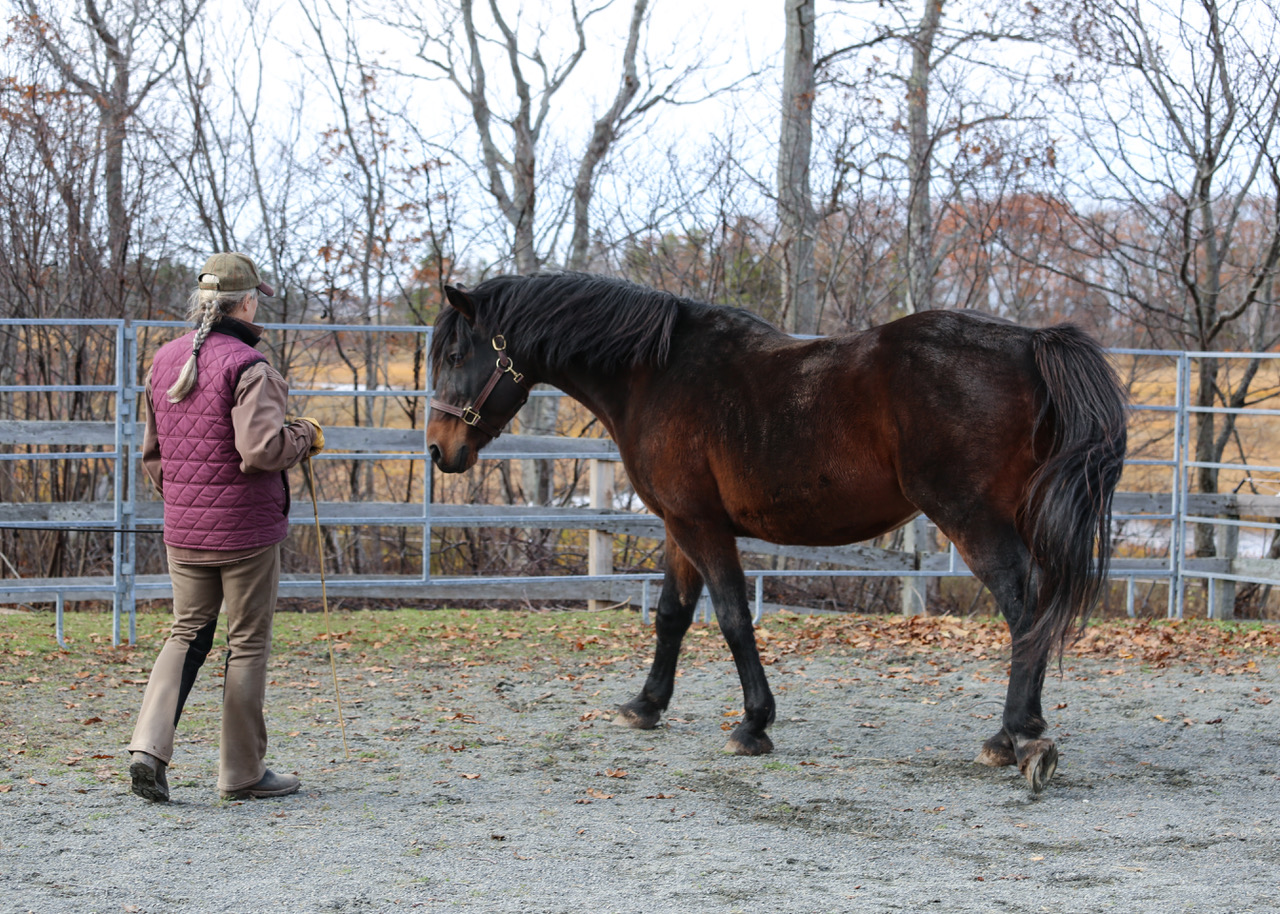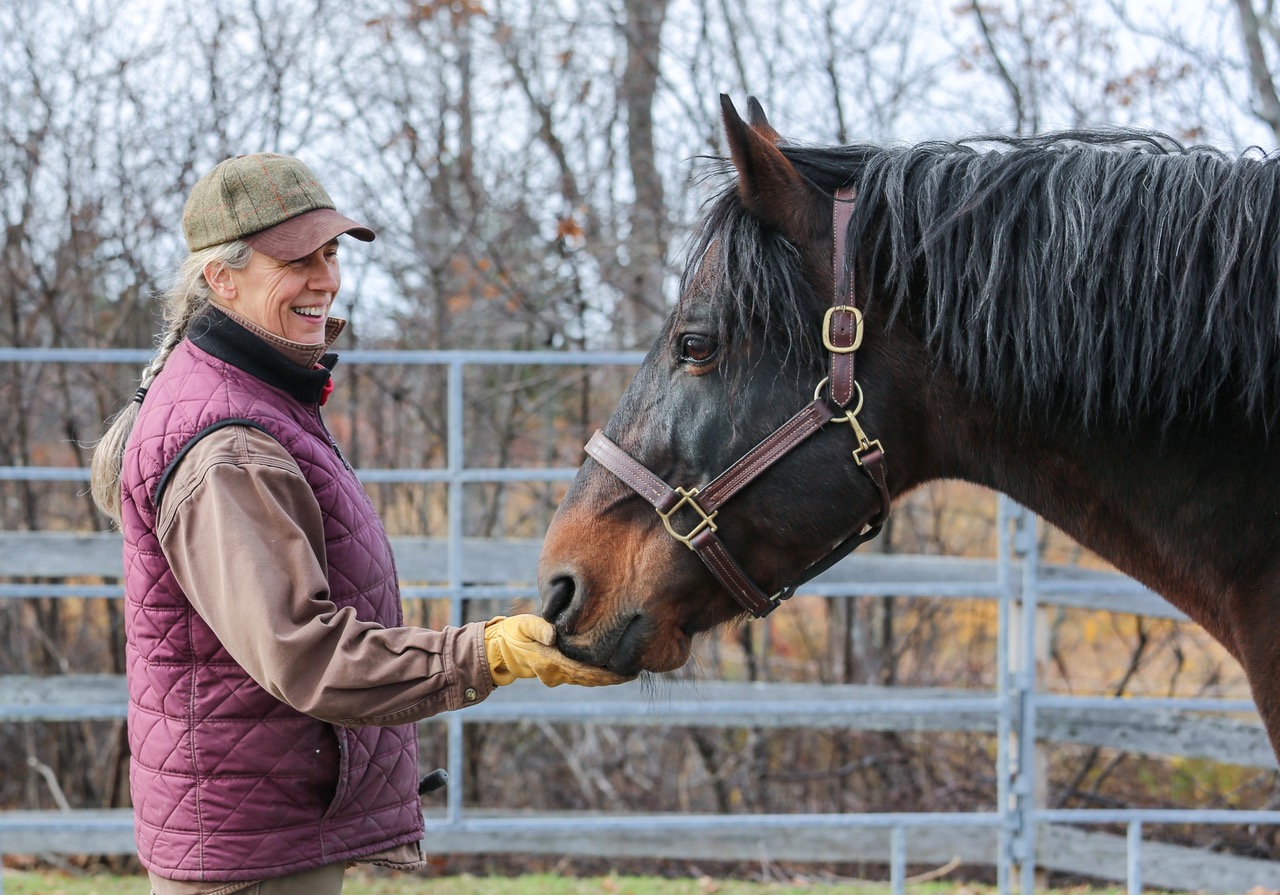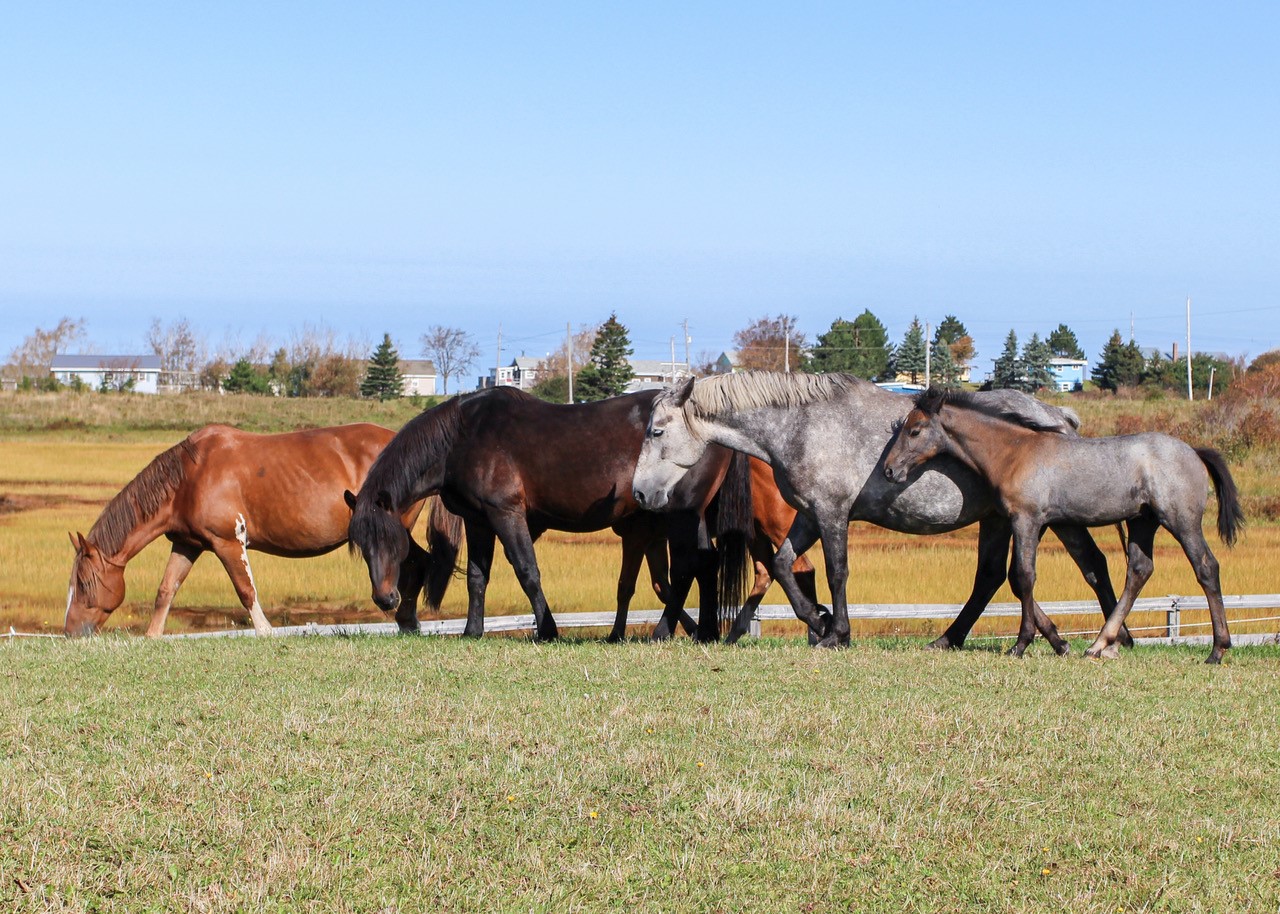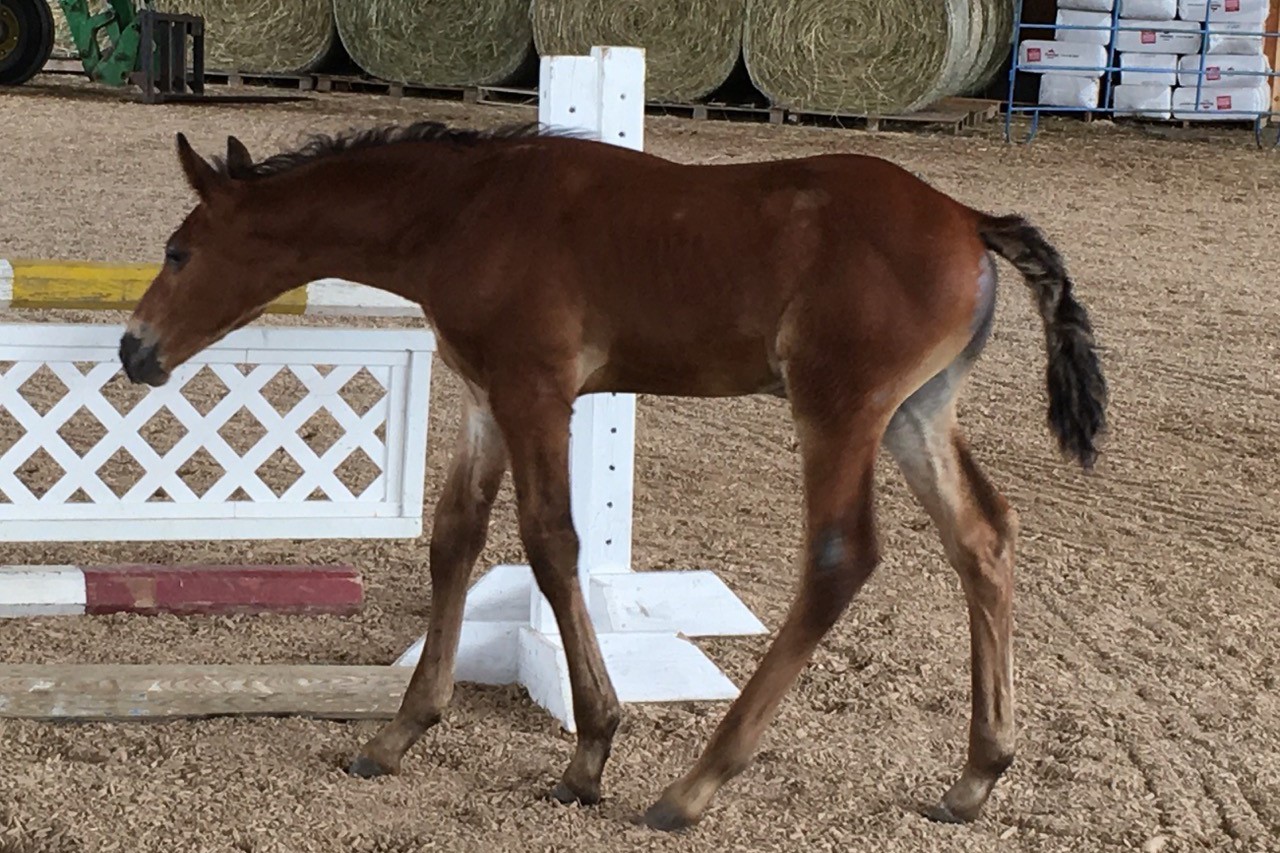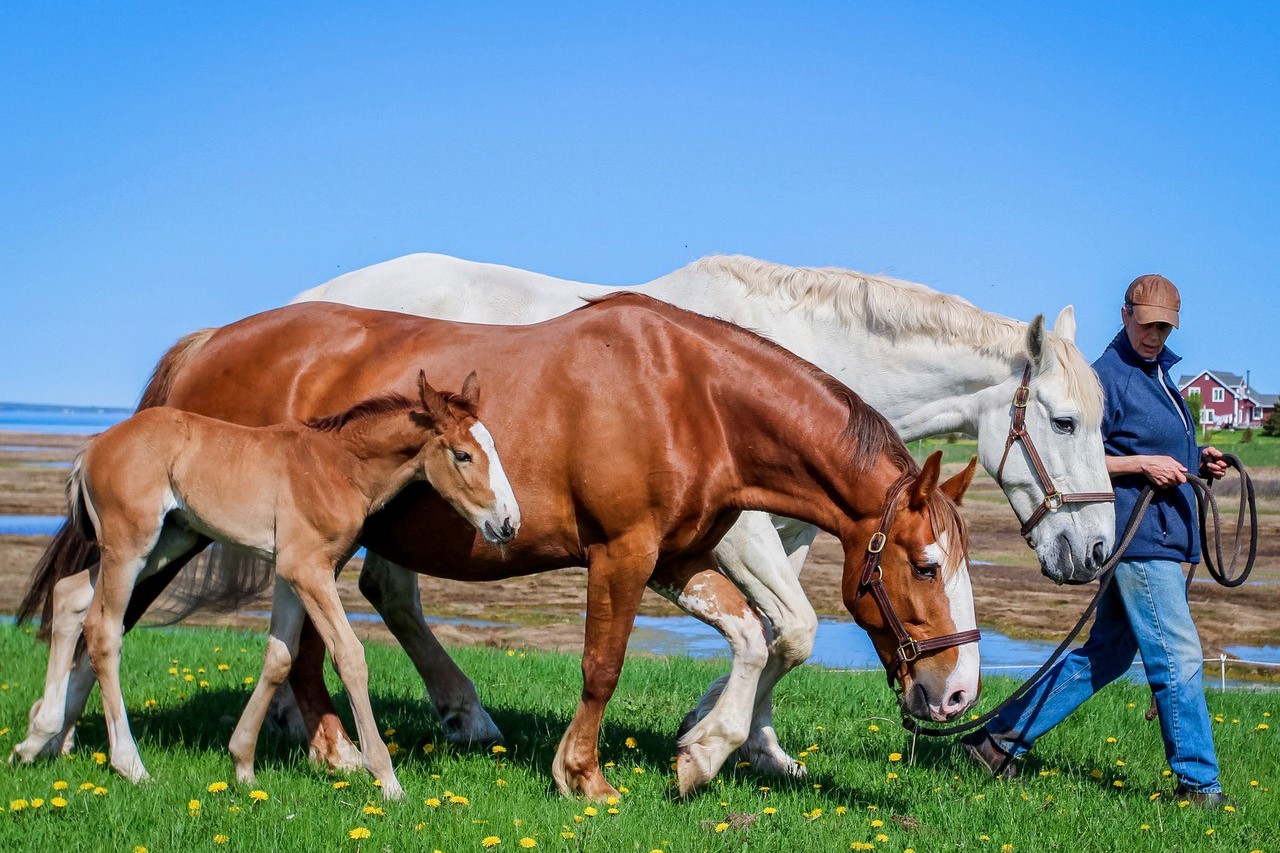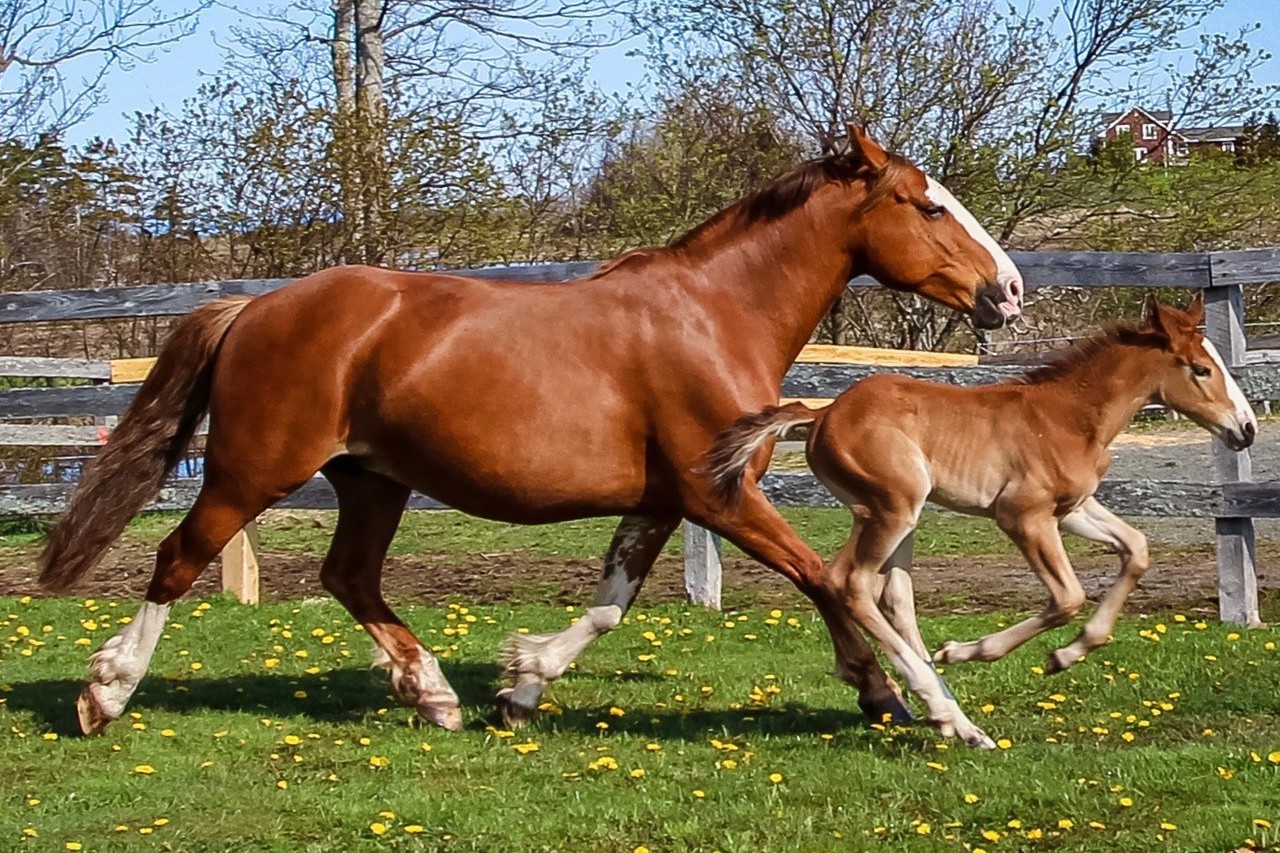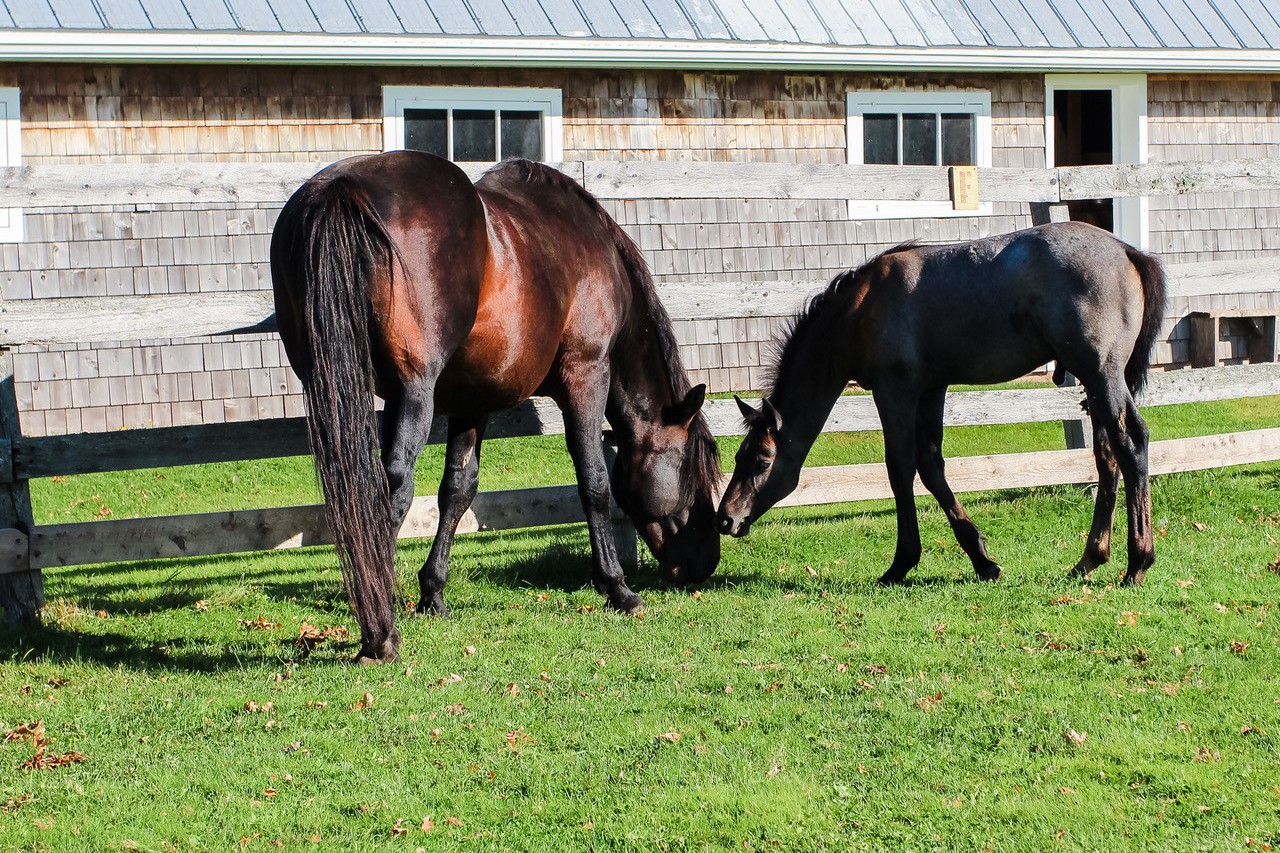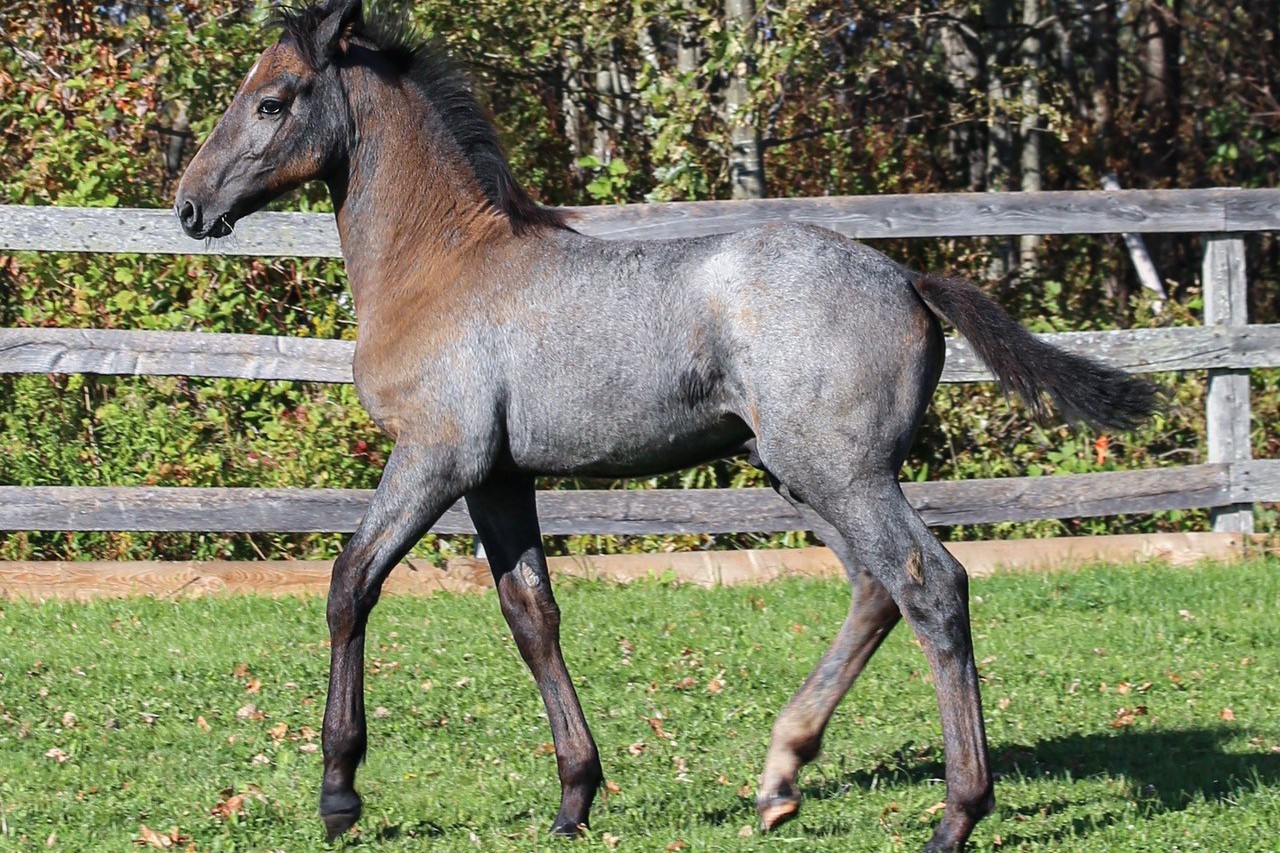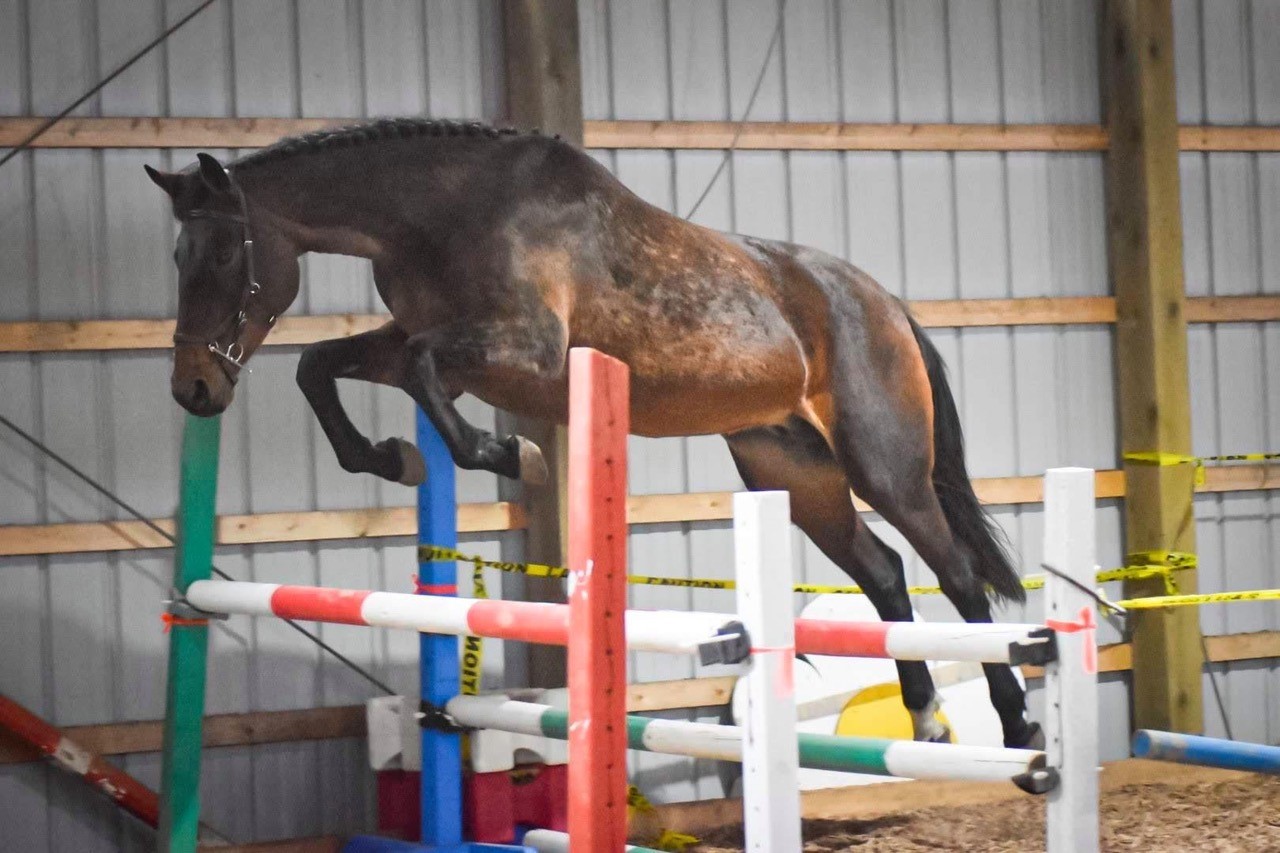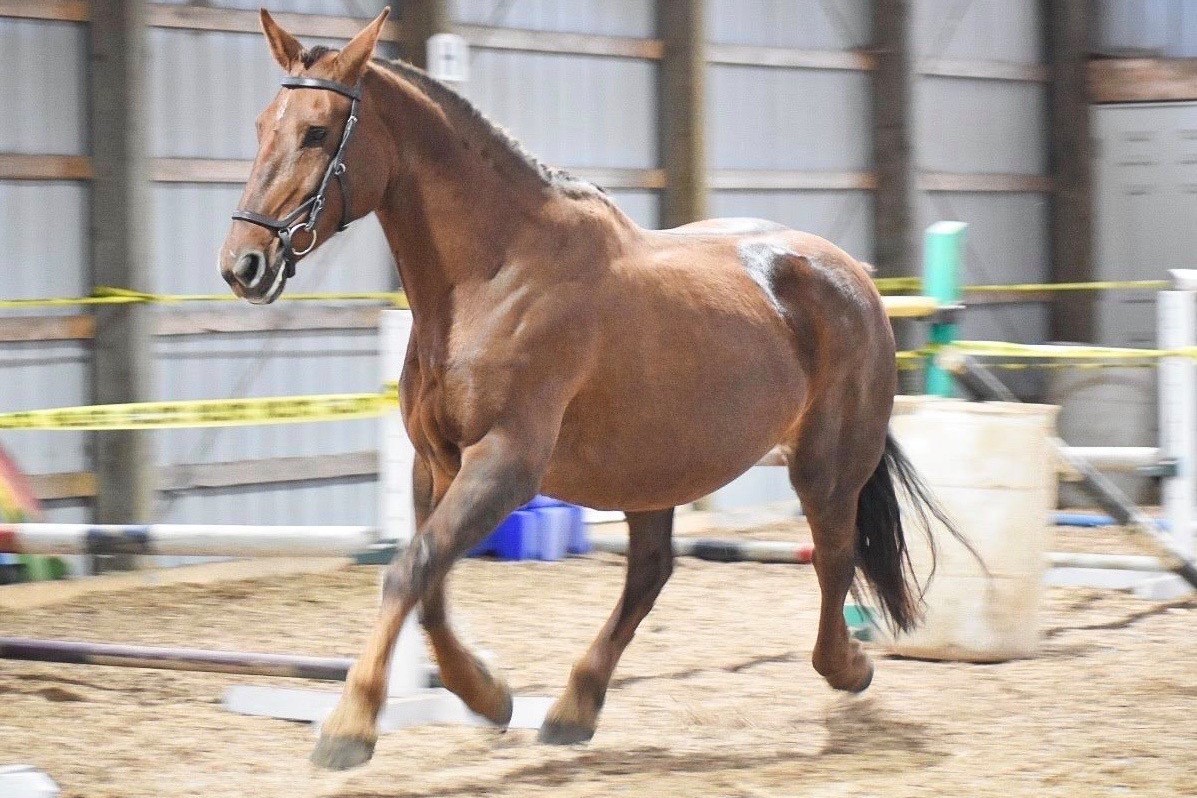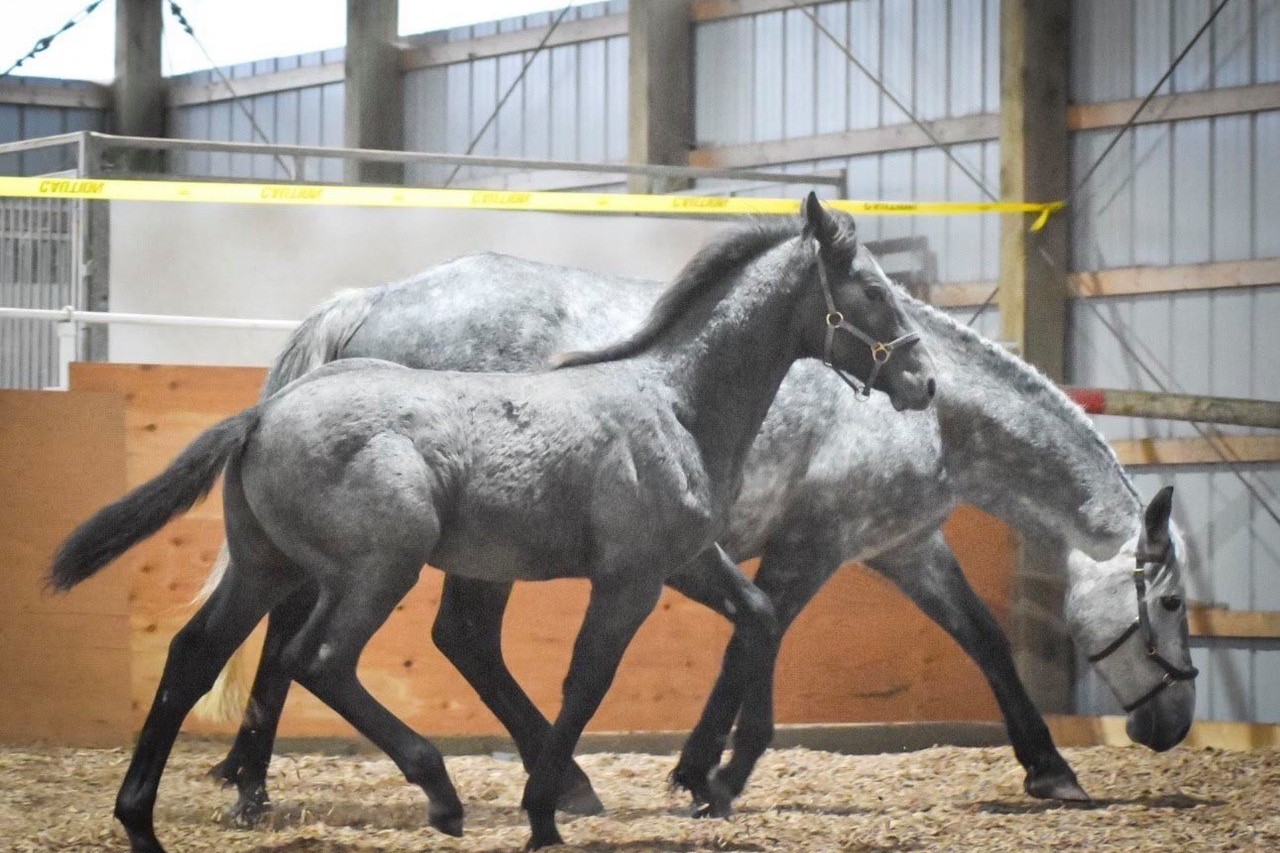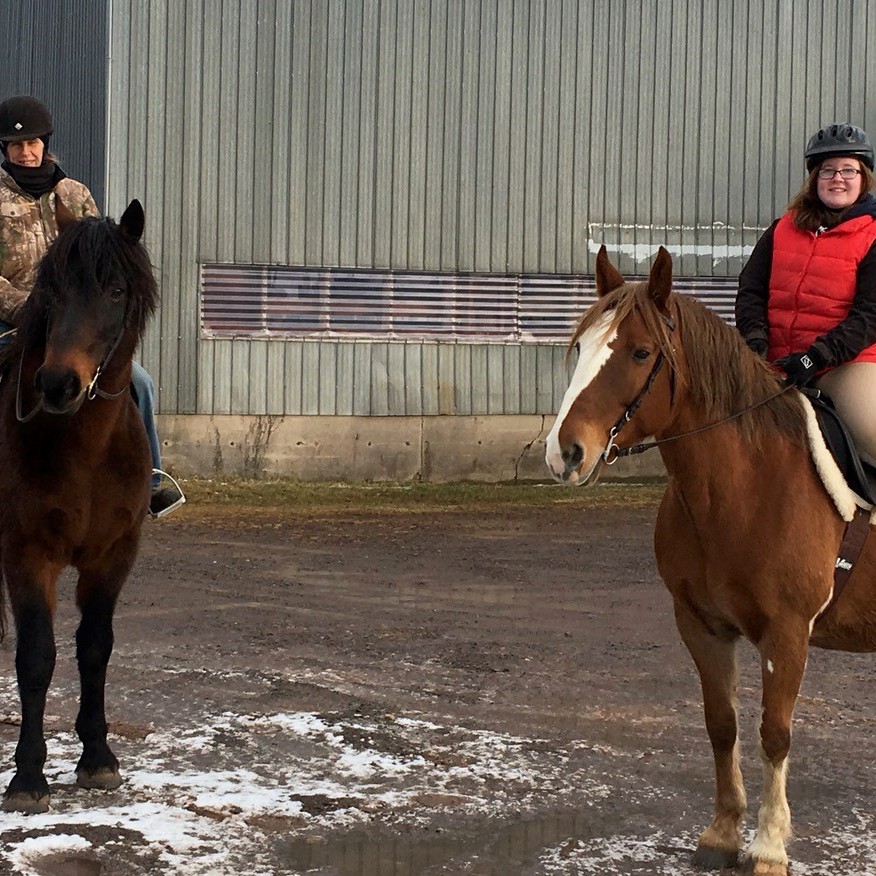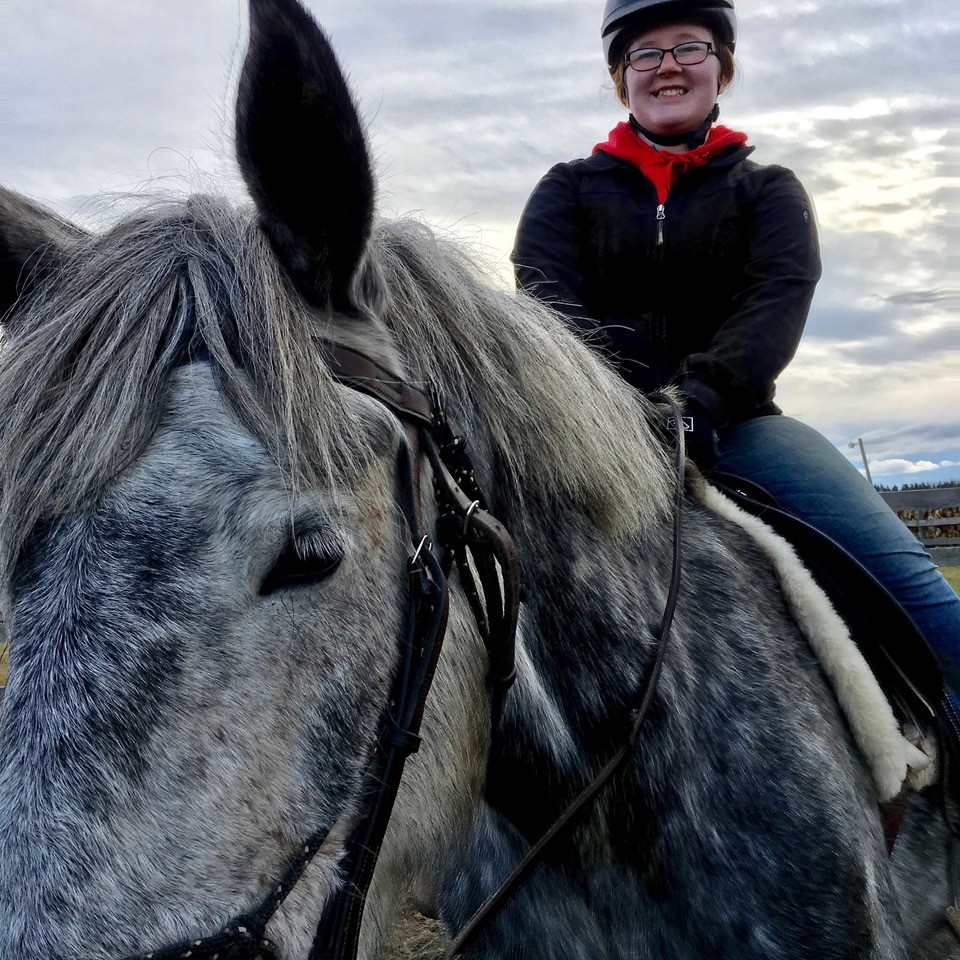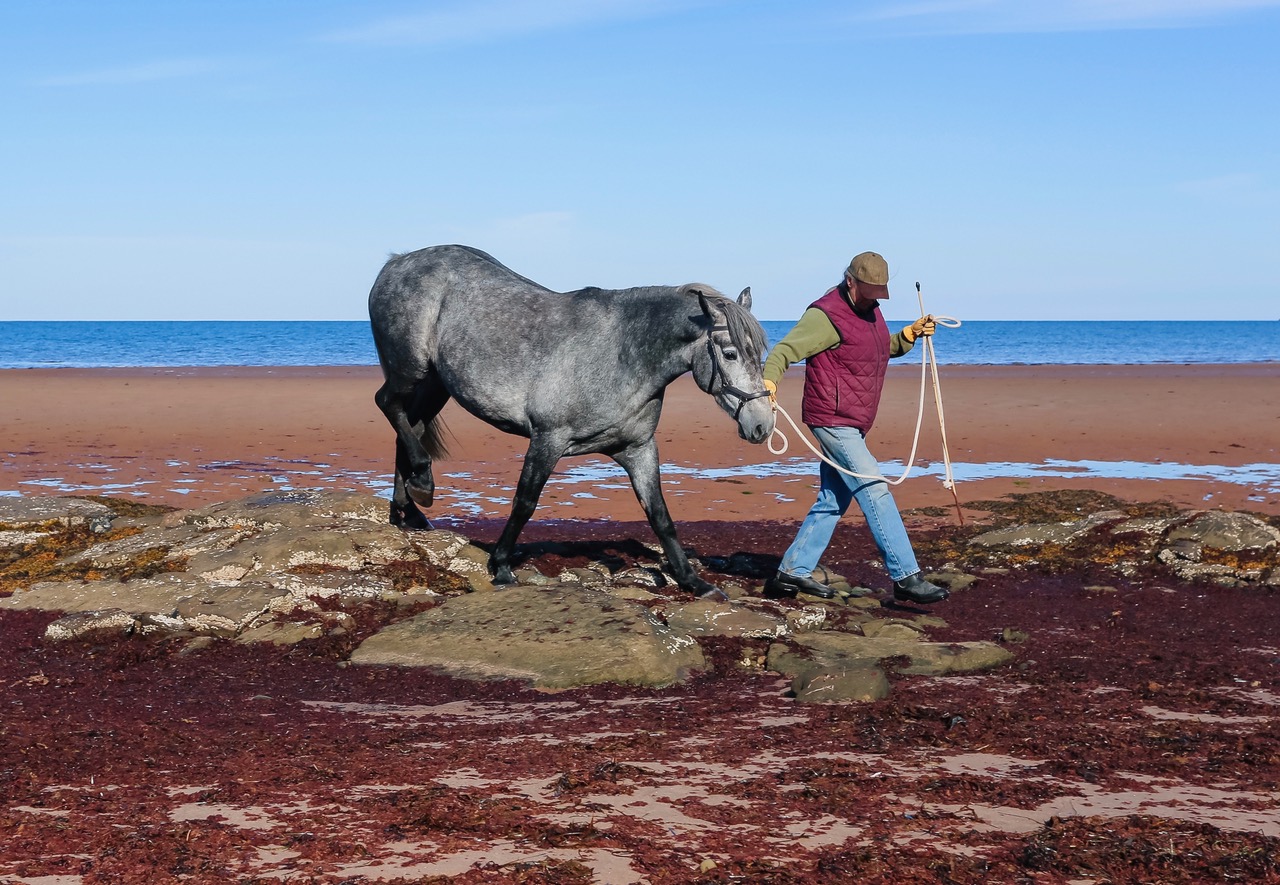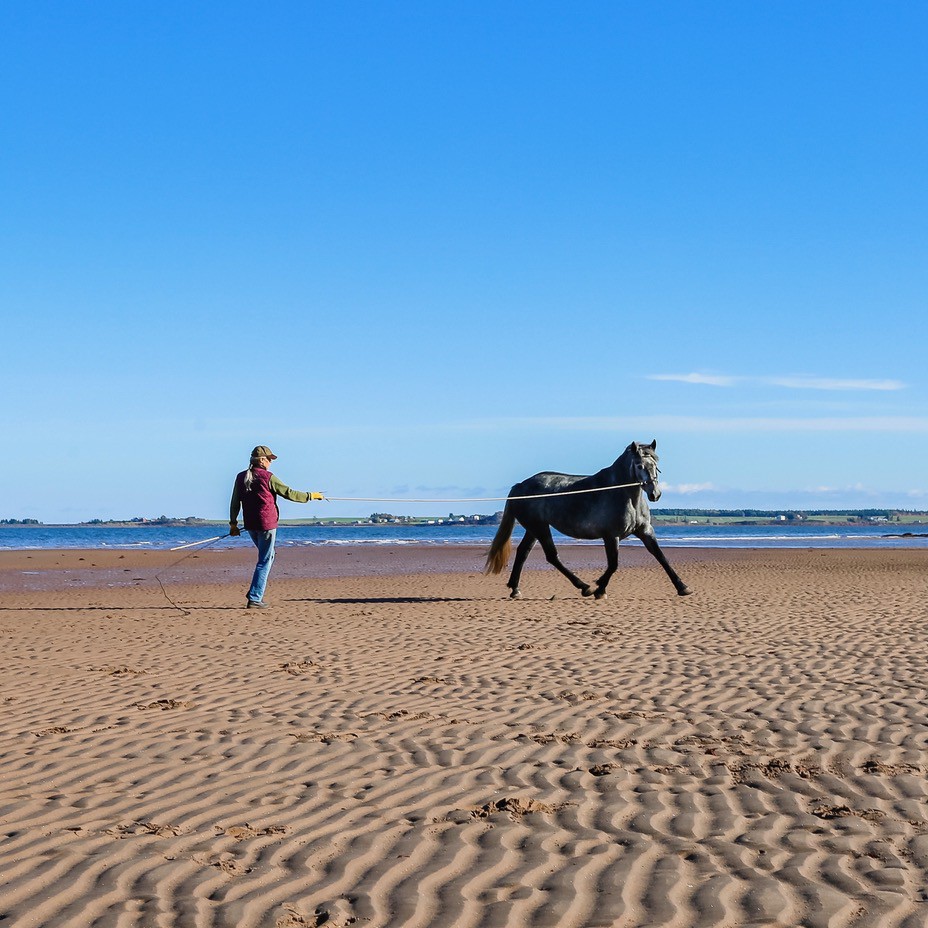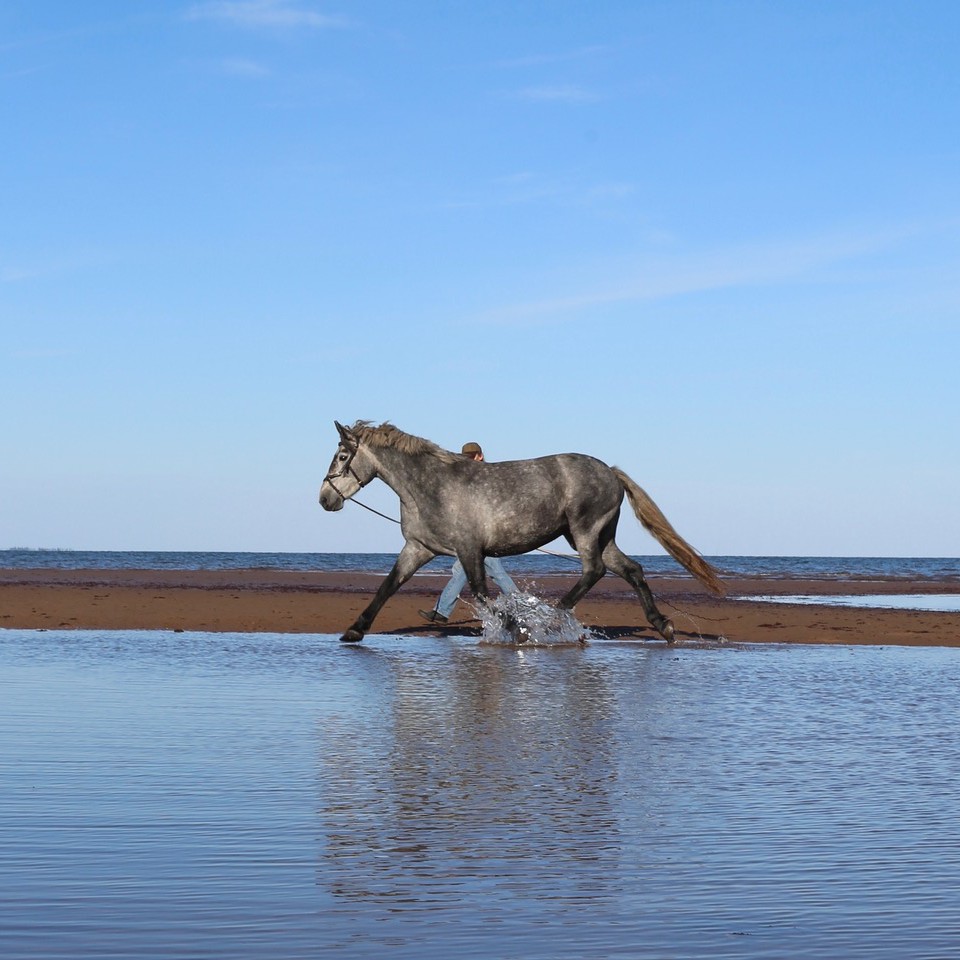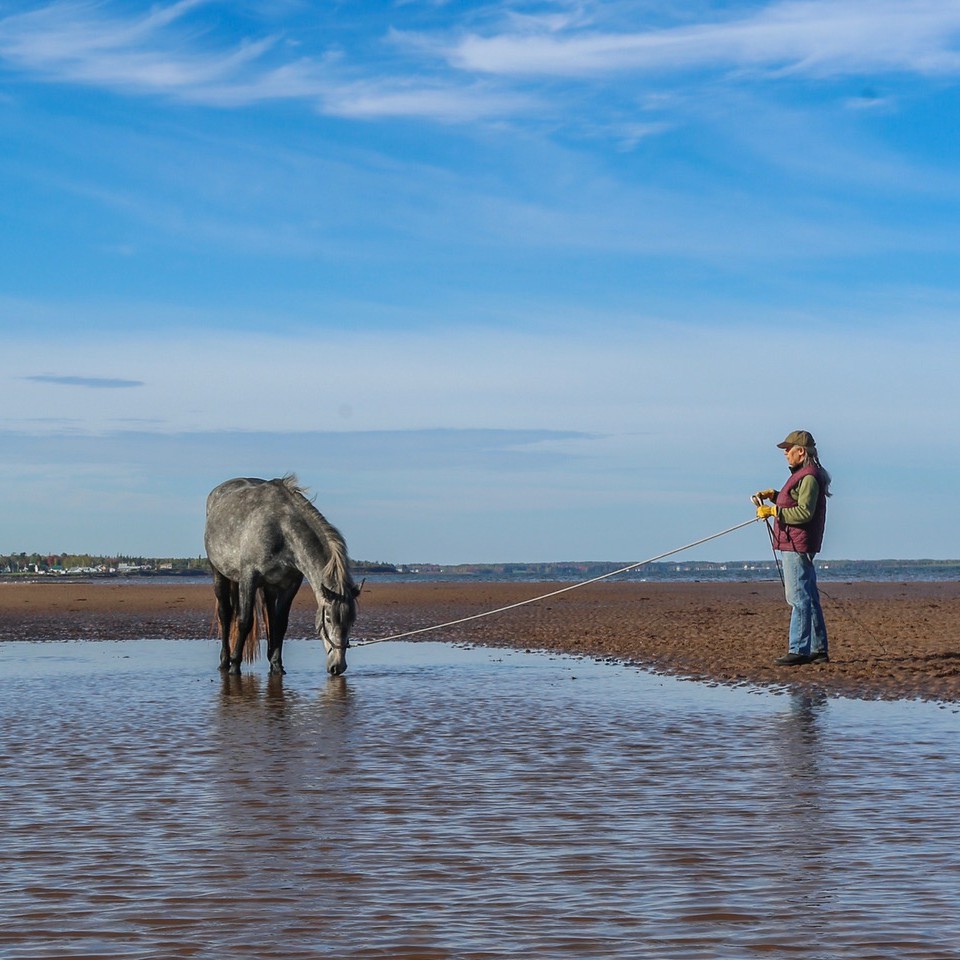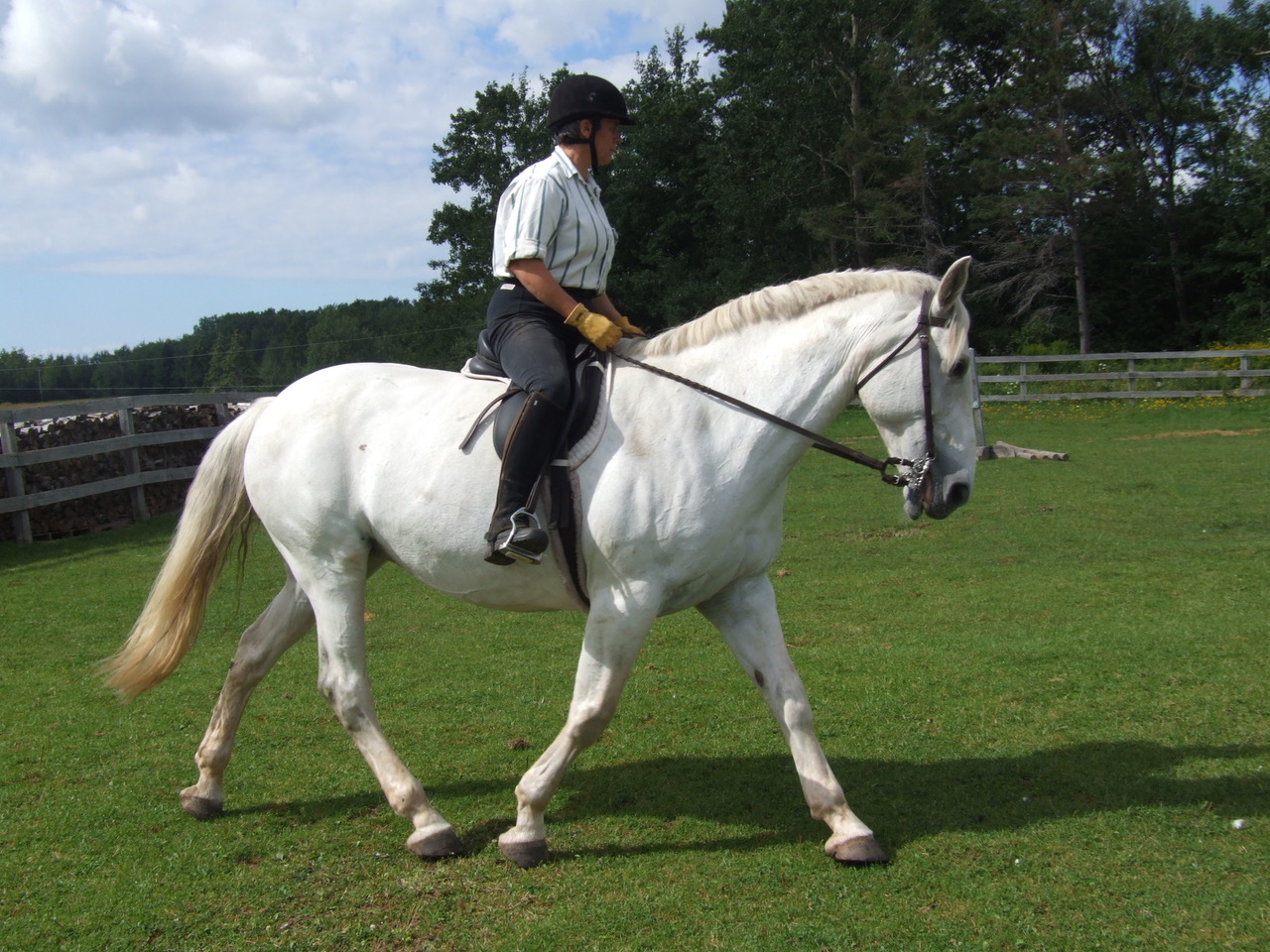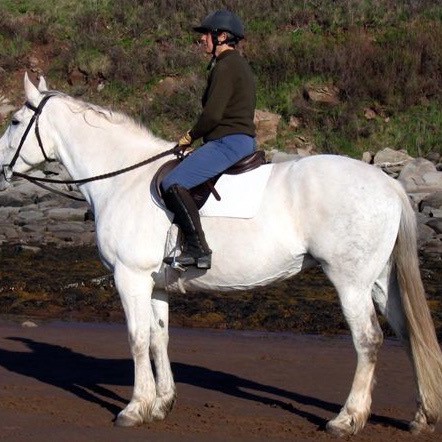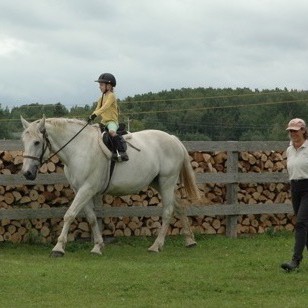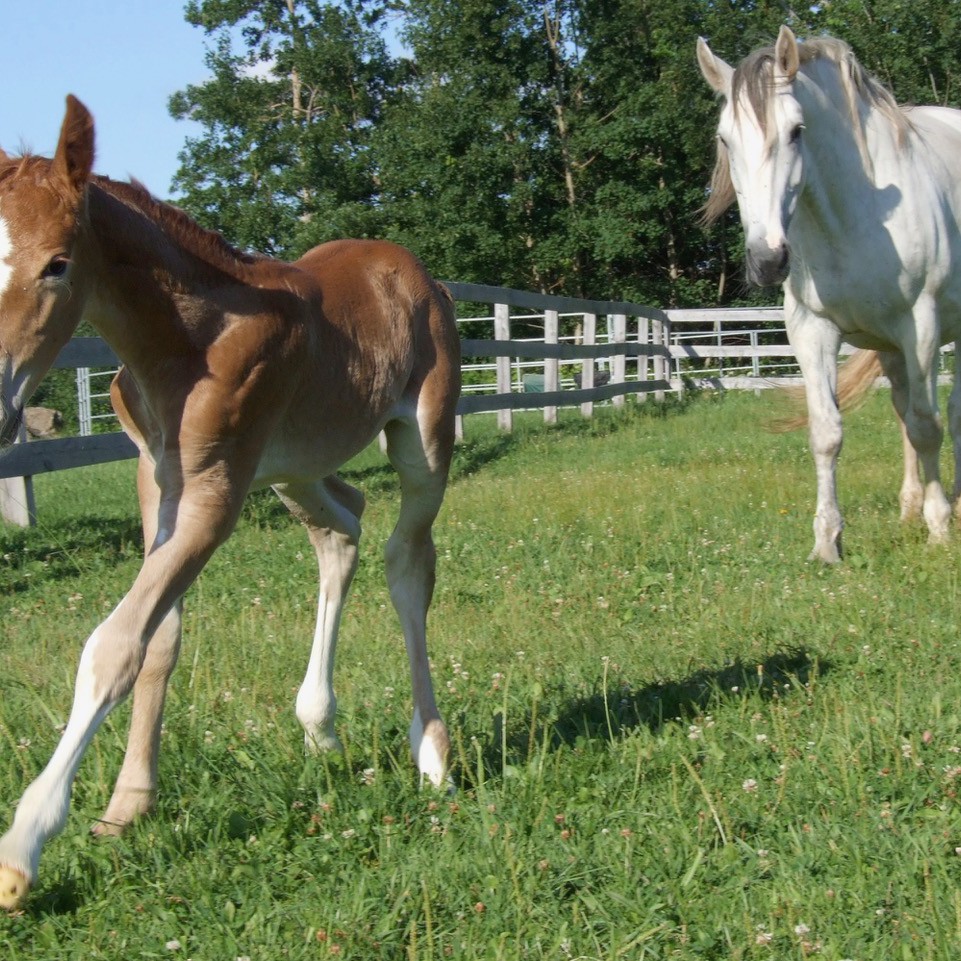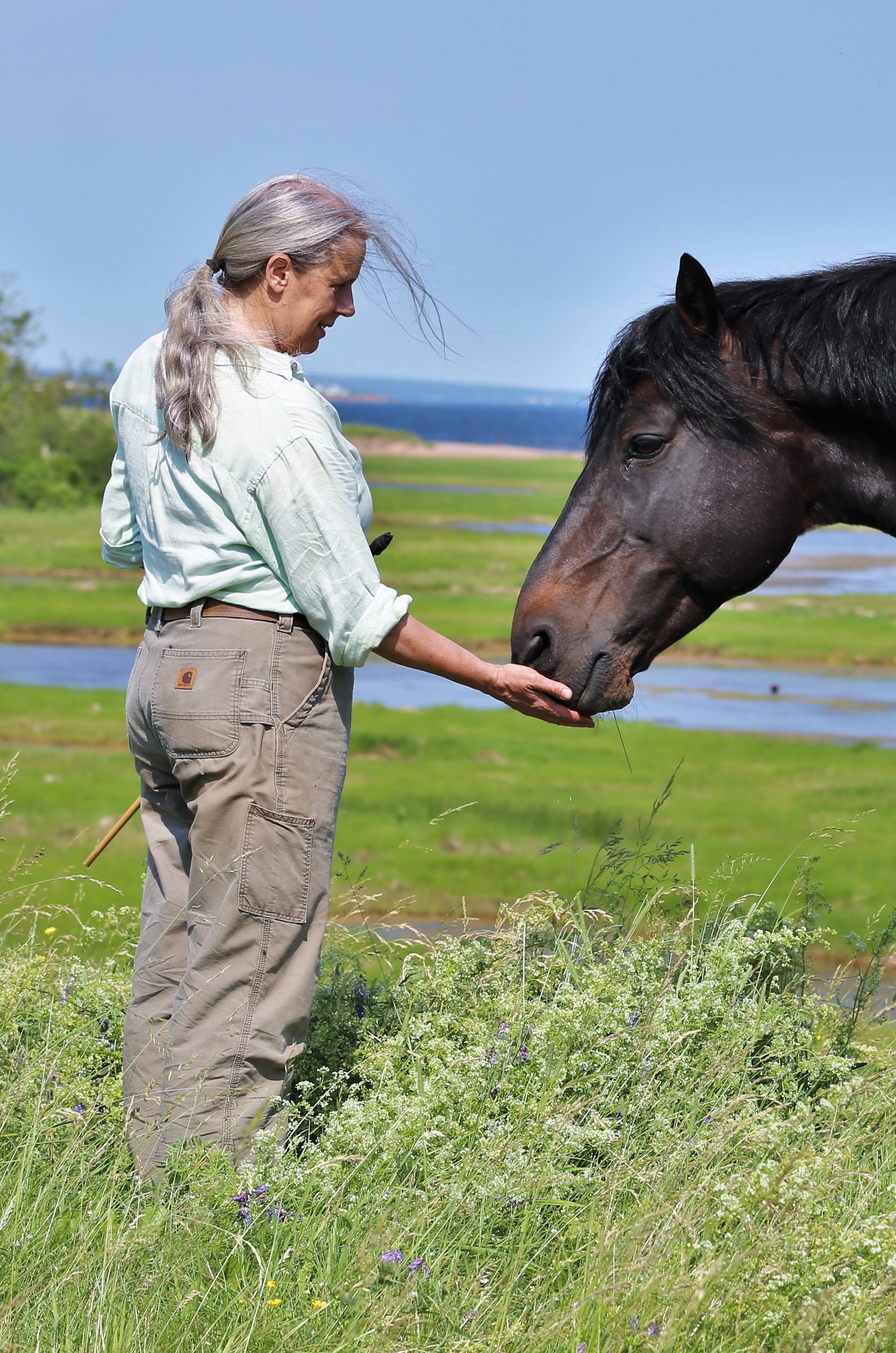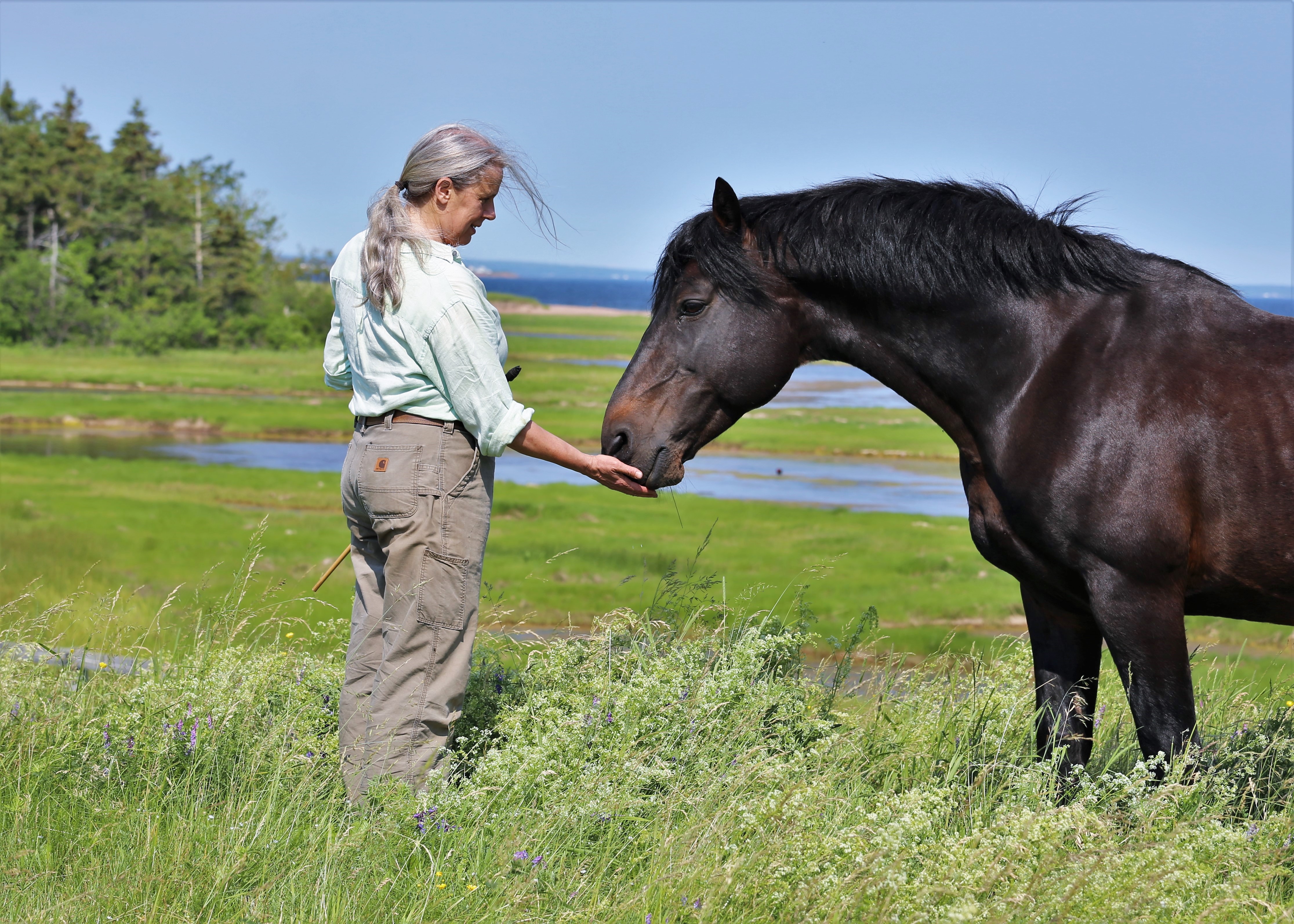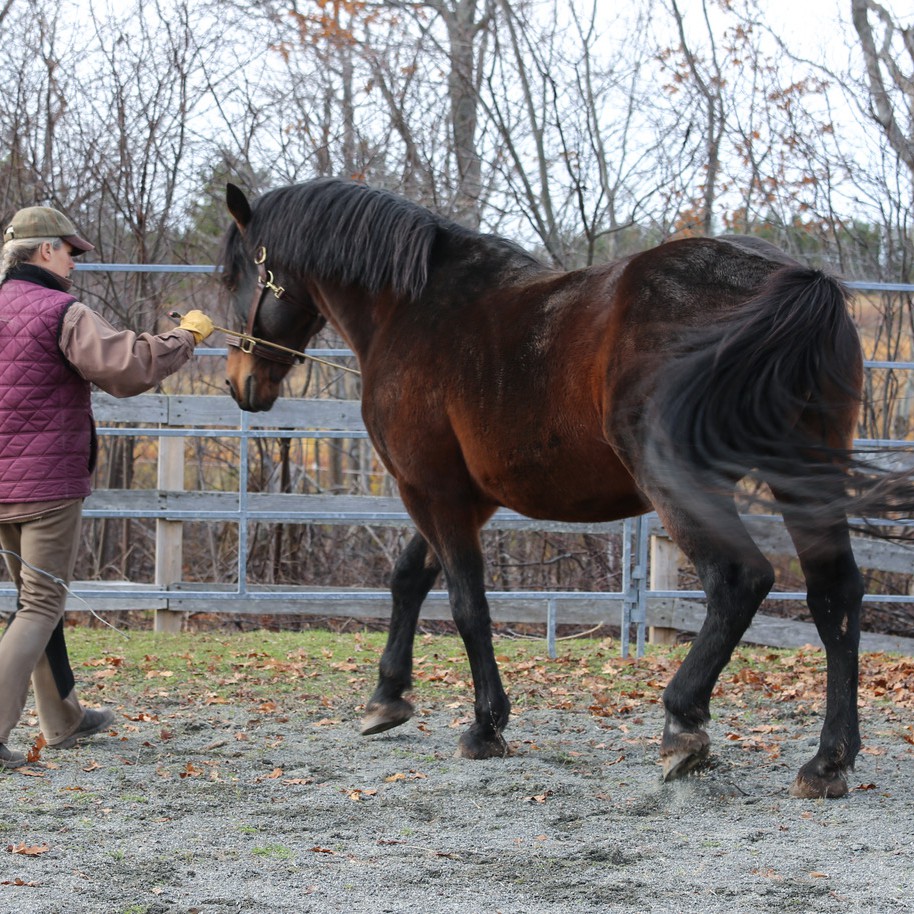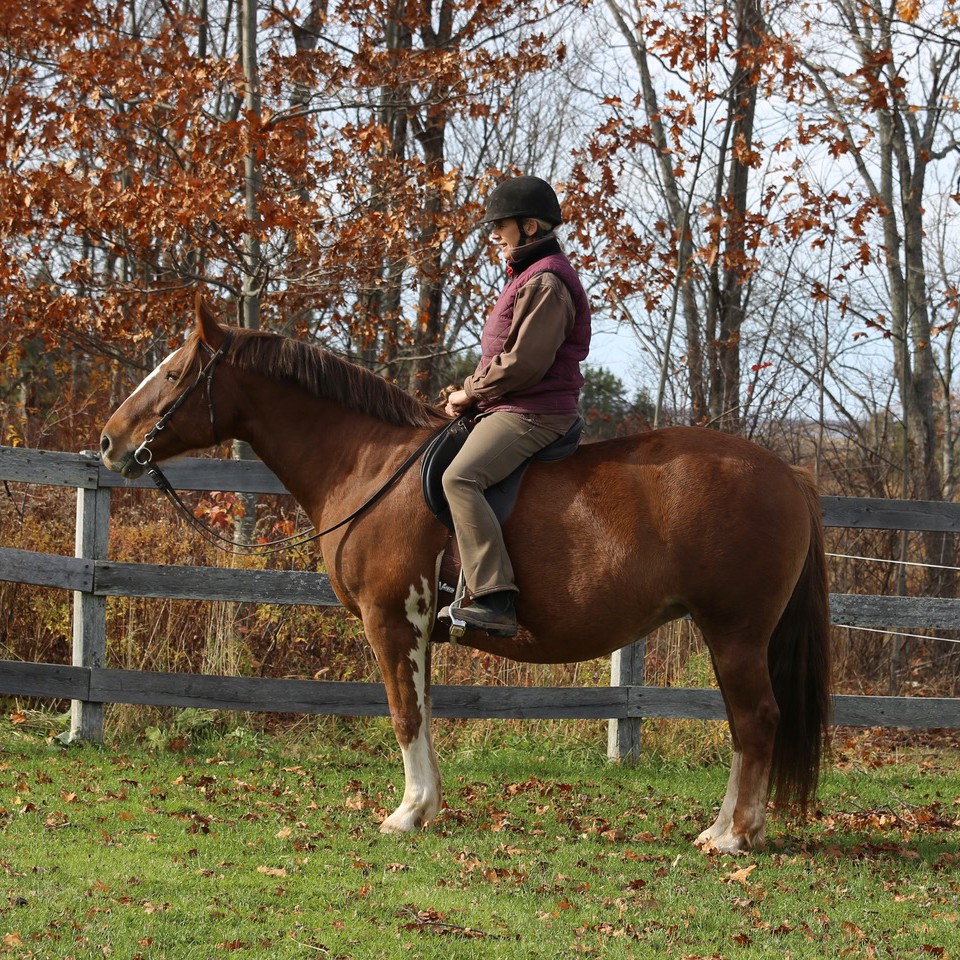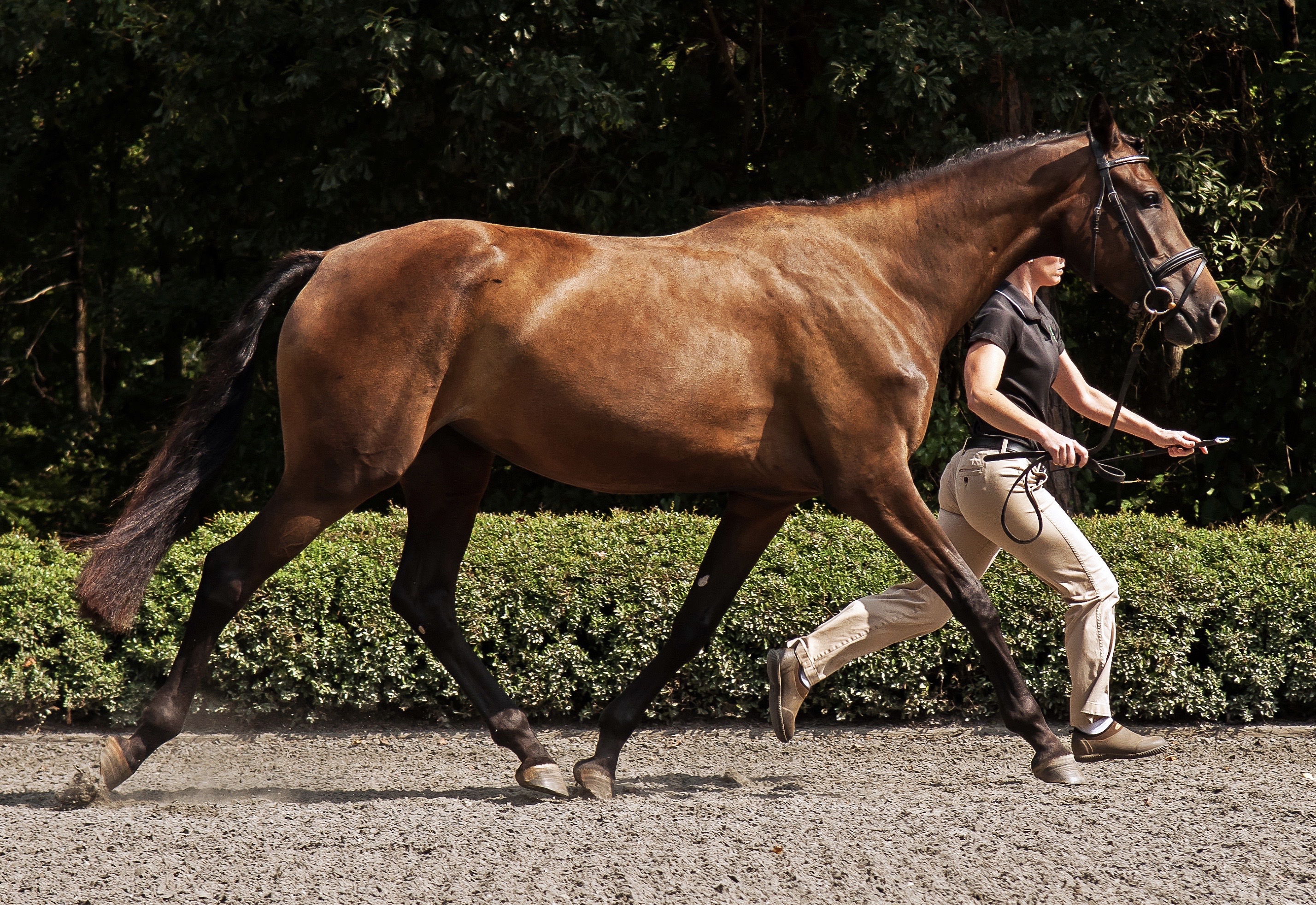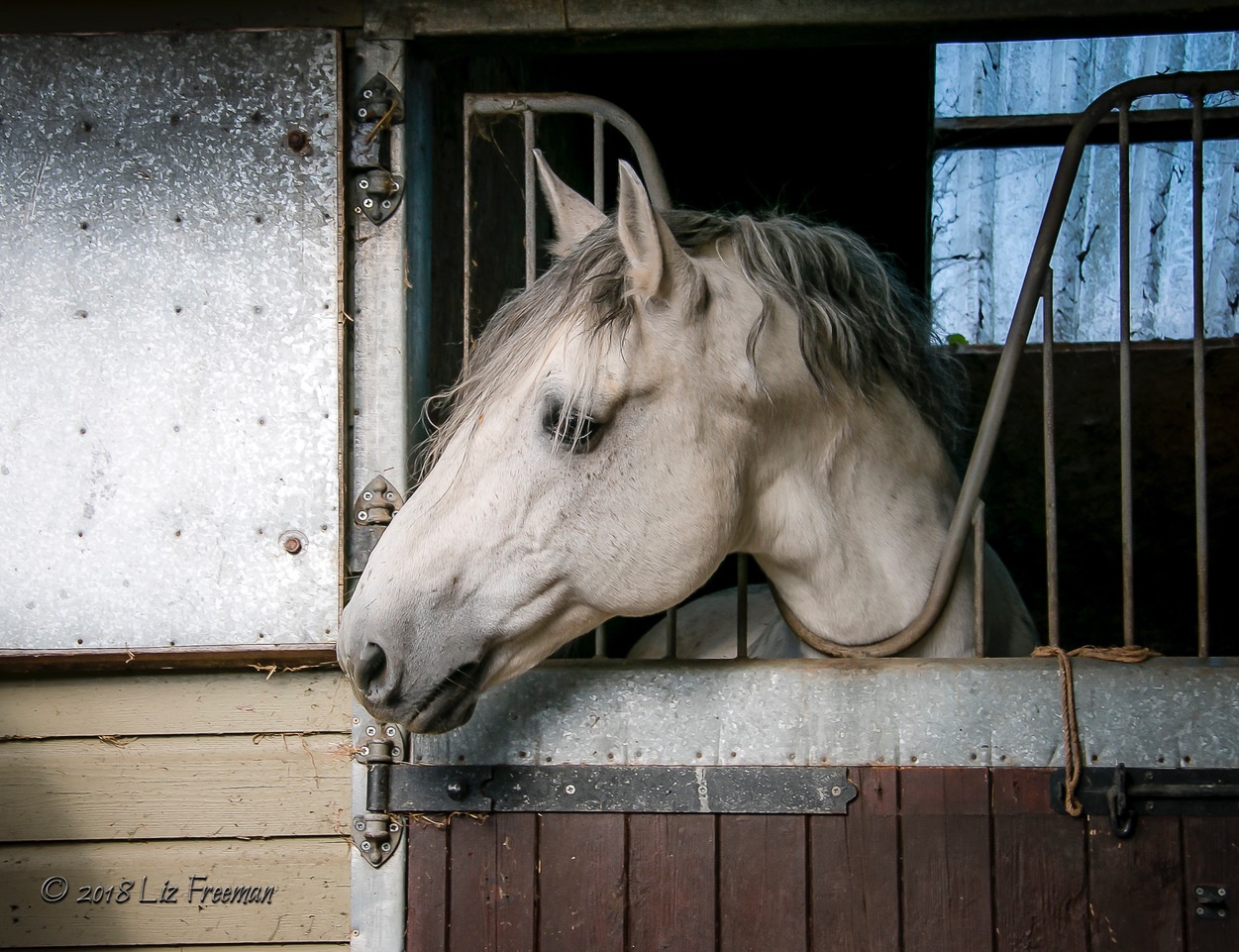It’s All About the Release
One fall day a few years ago, Image and I had a beautiful conversation about being connected to each other. My aspiration was – and remains – that he and I be equal partners in the dance of connection.
Image and his family entered the area where my training pen is situated. It is about 100 feet square with the 40 feet square training pen within it. It was a nice day. I took the mounting block inside the pen and left the gate open. The horses were nibbling bits of grass and exploring outside the pen. I came and went a couple of times when my assistant Evangelinia needed my input.
At one point Evangelinia and I were standing near the training pen gate when Image came over to say hello. That was nice, he doesn’t often approach for a greeting unless there is food. We said hello and I scratched his face, which he loves. I gestured for Evangelinia to walk into the pen with me to see if Image would follow us. And he did! She went back to her work and I sat down on the mounting block. Image sniffed around, delicately nibbled old dead grass shoots, and talked to his mares over the fence. The gate was open. He had choices.
Image approached to greet me as I sat on the mounting block. Then, I went to get a halter and lead rope from the barn. I chose a regular flat halter instead of something that might have implied “training” like a rope halter or cavesson. I returned to the pen where Image remained, and sat down again. He didn’t approach, but he also didn’t leave. The gate was still open.
Next, I walked toward him with the intention of putting the halter on. My intention was that simple: Can we be connected, please? I didn’t get ahead of myself thinking about all the cool things “I” wanted to do with him. No. Very simple. One thing at a time. Can we be connected? Like many horses he is a little bit sceptical of connection, but he is also a gentleman.
This is the point in the story that relates to the title. As I walked toward Image, I stopped the instant he responded in a way I could see. I was about four steps away from him, maybe eight or ten feet. Now we were in the conversation zone.
Horsemanship people talk about pressure and release as a training technique. But often they describe what strikes me as an exaggerated version that may include escalation of pressure before a release. Others don’t like that approach, and exaggerate in the other direction by attempting to avoid any pressure at all. I land in the middle. There is no life without pressure! Gravity is pressure. The blanket on my legs as I write is pressure. A hug is pressure. I feel a certain kind of pressure when someone walks into the room. Pressure is not good or bad, it is simply part of the physics of our planet and our bodies.
The instant I took steps toward Image with the halter and lead rope in my hand, he felt pressure. As best I could perceive his response, I stopped as soon as he acknowledged that pressure. That was the first release. Stop, and ever so slightly rock back while keeping my body and intention soft – pressure off. Then, rock toward him again in the beginning of a step – pressure on. He turns his nose away ever so slightly, I rock back – pressure off. I pause and take a slow deep breath. I start toward him again – pressure on. This time he flicks an ear toward me so I rock back again – pressure off.
This is the point I am contemplating. I gave Image the same release when I saw a “No” from him as when I saw a “Yes”. Tipping his nose away is a No sign. Nose or eye or ear toward me is a gesture of Yes. I am curious about that. In one instance, I communicate that I get the message that he is not ready for me to approach. In the next instance, I say thank you for staying open to my request. The same release communicating two different things. How interesting!
I was looking for him to stay open to me as I approached his face. There was more rocking as I communicated both, “I hear ya,” and “Thank you.” And there were a few pauses just for the sake of pause and breathe.
Once I got to his face, I gave him a scratch. He was positioned with his left side next to the fence, making it awkward for me to put the halter on. I tried anyway, but he tipped his nose away and moved off a few steps. He didn’t leave. However, he had turned and I now had open access to the easier side for haltering. This time he let me approach and did not turn away. I put the halter on and thanked him with a pause, rock back, and breathe.
The connection of a lead rope looped between my hand and the halter on his face is pressure. He can feel it and I can feel it. We tend to think of contact as beginning when the rope or rein is straight rather than looped. To the horse, contact occurs the moment they are attached to a human – or even before.
Image could feel and see my invitation to walk with me. He came along nicely. I made a few tight turns, both to keep him engaged with me and to test our connection. He followed beautifully. If the rope became straight I did not increase the pressure in response. Rather, I softened and invited using the same rocking of my body and energy as before. Or, I simply followed him within our small pen. Did he lead me to the mounting block?! Hard to say, but there we were so I stepped up onto it. From there, I scratched his head again. He didn’t leave. I came down off the mounting block, removed the halter, and thanked him.
All this took maybe ten minutes. It stayed soft throughout. Image could have left at any time through the open gate. This was my invitation to dance. My intention is to take this softness and connection all the way to riding. I aspire to practice advanced dressage movements with him, many of which he knows from previous training. I visualize those movements arising from the release, arising from the softness. Joyfully offered from “Yes,” “I hear you,” and “Thank you.” It’s all about the release!
Photo by Sarah Baker Forward 2021.
Abandon Any Hope of Fruition
When a horse turns away from the halter, I get curious. About my own behaviour: What did we do last time? Was I picky and demanding? Did I listen? And I get curious about the horse: How does he or she feel today? Do they hate the horseflies? Is it me with halter, or just me, or just halter?
This phenomenon used to hurt my feelings. But now I respond differently. Now, I am grateful that my horse is communicating with me! And I get inquisitive. Having made my way through this with Sylvie, I now know this dynamic can be the start of a very interesting conversation. Turning away from the halter is one way the horse can say “No thank you.” When that happens, I aspire to discover what will inspire my horse to say, “Yes!”
But first… I must abandon all hope of fruition. Let go of my plans and agenda. Place my attention on my equine partner with love and curiosity. And remember that this is a relationship that I want to feel good for both of us. It is out of mutual delight and pleasure that artistic dressage or joyful jumping or happy trail rides will come. And they will come if I attend to the conversation that is happening now.
Since I began spending time with Image a couple of weeks ago, he has been saying, “No thank you.” While he does say yes to trail rides, we can only do that occasionally since I am alone on the farm most of the time. So I have abandoned my plans and ideas about riding (which is REALLY hard!). Instead, I set up a goofy obstacle course in my riding ring as a playground for everyone. Pool noodles, labyrinth, small bridge, and more. Image was first up and he said “Yes.” I took him around first and he negotiated everything with only a little hesitation, then my older student took him, then the young student. Then we try with the others, eight year old Trudy and the yearlings.
As we go through the obstacles, my attitude is inquisitive and playful. I don’t care if we get it “right” or even get through every one. We are finding things out together! I note what is easy or hard for each horse and each human. If I can, I include a more confident horse to help a less confident horse. I encourage my young human students to just try and see how it goes. Messy is great!
Going around and through the obstacles reveals the spots where communication could be improved. To negotiate the various obstacles requires some basic vocabulary – stop, start, left, right, forward, back, pivot, one step, move your shoulder, move your bum, and so on. Each horse shows where they need help, or rather… where I need to communicate better what I am asking for.
So this week we are all reviewing that vocabulary. Image knows it but has a habit of bracing, so we are exploring different ways of asking that help him stay soft. Trudy is unsure about even coming to the conversation, so the haltering is particularly interesting. The yearlings are willing and love the attention. They just need to expand and refine the responses we have established through routine handling: move this part of your body, come with me, don’t crowd me, stand for trimming, and so on.
The dog days of summer are a good time to not try too hard. To relax and have fun. To abandon any hope of fruition. If the horseflies are bad we just play in the barn aisle. Sometimes it is just grooming and loving, remembering that every interaction between human and horse is an opportunity to build our relationship. One day this week I put a saddle on Image and explored how we do through obstacles with only a rope halter! That was fun… and revealing!
The answer is, “YES!” I practice YES. I look for YES. Much easier to do when I have let go of attachment to a particular outcome! Everyone wants to feel encouraged, animals included.
NB: “Abandon any hope of fruition” is a Buddhist slogan included in a body of teaching called The Seven Points of Mind Training. For more, here is an article by Pema Chodron: https://www.lionsroar.com/dont-give-up/.
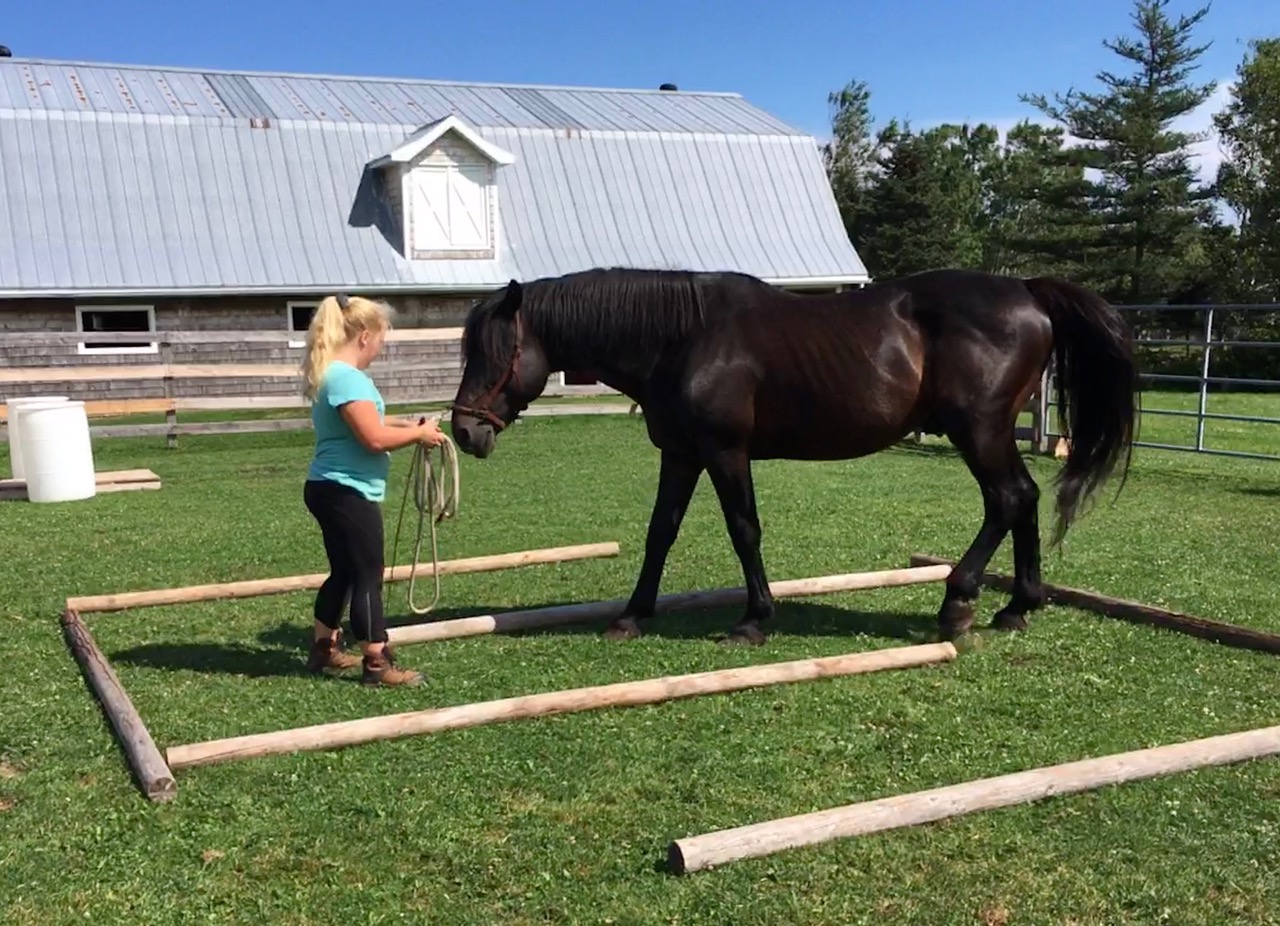
“Image and my student Anna through the labyrinth, photo by Katharine Locke.”
Leading and Following: Who is Training Whom?
I am very happy that riding and training has risen to the top of my priorities! Image, with his years of education, is amenable to me just getting on and riding. Trudy is eight this year and ready for a re-start after two years of being a brood mare. Then there are three yearlings – Artie, Lad and Cara – who benefit enormously from practicing basics at this age. In a way, I am doing the same thing with all of them. And each will help me tell pieces of the story of equine human relationships at Fourwinds Farm.
I am so grateful for Image! To have a horse I can just get on and feel safe there is blessing. Image had consistent training through his life and knows his manners under saddle. That allows me to take time to renew my seat and position, and explore my breathing and posture. The biggest risk with Image is that he will stop and not move! So I am free to establish my foundation and consider how to have a riding conversation with him.
With Trudy I am going back to the very beginning. She was started and ridden as a young mare so she will likely progress quickly. Trudy is a strong minded mare, just how I like them! Sylvie and River trained me well for her. Like them, if Trudy is sceptical of my intentions she will walk away when I approach with the halter. So I respect her feedback and prioritize her feelings over any agenda I might have. One day this week she took five or ten minutes before she accepted the halter. The day before I had put a bit in her mouth which was clearly not one that suited her. So we mostly groomed and then spent a few minutes in the barn aisle taking very slow steps, forward one at a time, back steps here and there, and a few of shoulder-in type steps. Easy and soft.
The yearlings mostly just get time improving basics like leading, tying, grooming, and so on. They’ve done much of this already of course but now they get a chance to be part of the horse-in-training rotation. My goal is that they have a small experience with me that is enjoyable and – if they are ready – add a new experience as well. If needed, I give them a horse buddy for support and encouragement. My highest priority is to build on the trust and friendship that we already have.
The theme here is the title. I am leading and following, both training and being trained. I do have skills to coerce my horses to do things, and I use them to protect my safety or in an emergency. But my preference is to not use them the vast majority of the time. My preference is to have a genuine conversation with all the implications of that word. It means I speak and listen, really paying attention to what a horse is telling me. In part I do that by really tuning in to my own body and its response to the horse’s body. I want it to be a conversation between friends. One where we both can say, “How about we try this or go there?” Or, “How do you feel today and what shall we do together?” In human relationships we are training each other all the time! Good ones are characterized by encouragement, joy, healthy boundaries, taking turns setting the agenda, love, and deep curiosity about what makes the other person tick. It can be the same between my horse and me. We begin by training each other to develop a shared language of touch, gesture, posture, and energy.
My intention is to keep telling stories about how this unfolds for us this summer and fall. I am so fortunate for the everything here at Fourwinds Farm! My aspiration is to share in this small way.
Photo of me and my dear departed teachers, daughter and mother Sylvie and River, by Sarah Baker Forward 2019.
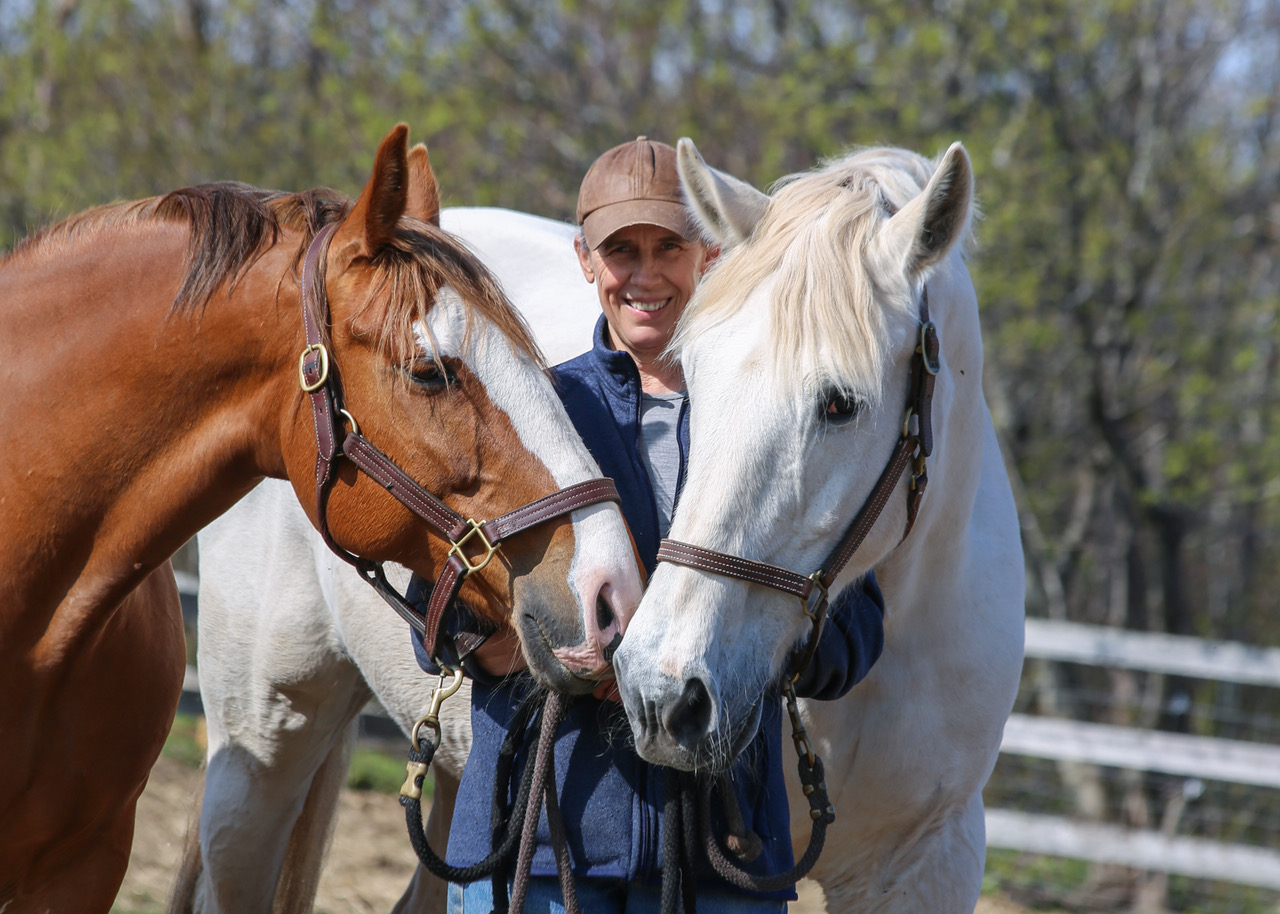
Fourwinds Farm 2019
Last year brought the fruition of fifteen years of work, study, selection, investment, and love. Always love! In 2005 I acquired my first Irish Draught mare – the inimitable River Run – selected as a mate for the equally inimitable Garryowen of Suma – with whom I had fallen in love. The next year Sylvie was born, my first Irish Draught foal.
September of 2019 was the end of an era at Fourwinds Farm. We laid River to rest on the hillside overlooking our marsh. Hard to come up with the next sentence…. It was her time, she was 27 and struggling with a bad hip. And I miss her terribly. She was a true foundation mare for me in every sense of the word. She gave me Sylvie – who is producing for me now – and she set the tone in the herd for fifteen years. River carried me and many others with grace and generosity. My heart swells with gratitude that she stayed long enough to meet and get to know her first surviving grand baby. River’s legacy carries on!
Foals!
Phew! I forgot how much work it is – and how much fun! – to have a crop of foals. We had two Irish Draught foals by Moorpark Image RID here at the farm, and an Irish Draught Sport Horse foal by Lionwood Kinsale’s Lad ID Class 1 born elsewhere. I could not be more pleased with them all!
Fourwinds Caraway is daughter to Fourwinds Sylvan River RID (Garryowen of Suma x River Run), the result of that inspiration fifteen years ago! Through no fault of her own, Sylvie’s breeding career has gotten a late start. In the meantime she and I have dabbled in driving, trail riding, classical dressage, and more. She would love a show career, poser that she is, but her person – me – doesn’t do that!
Caraway looks to be taking after grandma River in many ways. She has the look in her eye and the steady demeanour of River, as well as her sensitive and forward nature. And it looks like she will be well over 16 hands at maturity. Cara’s movement is exceptionally rhythmic and correct, with a generous overstep. Image contributed calmness, the bay colour, and more.
Cara is not for sale. We repeated the breeding for 2020 and the foal is likely to be offered for sale.
Fourwinds Artisan is a grey colt out of All Maybelle ID Class 1 (Lionwood Kinsale’s Lad x Pearl Drop by Castana). Artie showed up with tremendous bone and beautiful straight limbs. He is sweet, confident, independent, and people oriented. He has Image’s beautiful face and soft eye. Artie may end up a compact model around 16 hands.
Artie will be offered for sale at some point. This cross has also been repeated, the 2020 foal is spoken for.
Fourwinds Daring Lad is a tall bay colt out of Connemara Sport Horse Brambleridge Truth or Dare (Salute the Truth x Sparrow’s Tiptoes by Grange Finn Sparrow) by Lionwood Kinsale’s Lad ID Class 1. He is Angus’ first North American foal since he moved to Ireland, and the first conceived with his frozen semen. Royally bred for eventing, Laddie is a top class Traditional Irish Horse with potential for high level competition.
Lad will be offered for sale at some point. We may repeat the cross for a 2021 foal.
Inspection
With foals safely on the ground and repeat breedings accomplished we turned our attention to Maybelle’s inspection by the Irish Draught Horse Society of Canada. Maybelle achieved Class 1 status, affirming her quality as an Irish Draught mare. She and Artie impressed us all with their calm demeanour through trailering and performing in the midst of a Maritime storm with bucketing rain and strong wind. They took it all in stride!
The inspection was a resounding confirmation of the quality mares in our small region and of Fourwinds Farm mares in particular. In addition to Maybelle, homebred Fourwinds Juniperus (by Clover Cliste RIDSH) – now producing lovely sport horse foals of her own – was approved. All four mares presented had excellent results: the Irish Draught mares received Class 1 status (with Emilie Murphy’s Windfield Belle of the Ball receiving Bronze Merit for Athleticism, Conformation and Movement), and the part bred mares were recognized as Approved Irish Draught Sport Horse. Three of the four are in foal for 2020, with Juniper and Maybelle expecting Image foals.
Riding and teaching
Fall found us focused on training, riding and teaching! Sylvie stepped up as my partner in teaching three young students. My assistant Evangelinia O’Brien is one, and she made tremendous progress in her riding this fall. We are now a fabulous trail team with her on Sylvie and me on Image. Sylvie will go anywhere, and Image will follow her anywhere!
Maybelle made progress in her basic training, and Evangelinia was her first rider up in early January. As expected, she calmly went along with all the new experiences of longing, long lining, backing and so on.
Image and I have finally begun our riding partnership in earnest. With his extensive training from former owner Adam Gamble, Image presents an opportunity for me to go deeper with my classical dressage practice.
The horse family
The most joyful development of 2019 was the dynamic of the home herd: the horse family composed of Image, his mares, and their children. Carefully managed and years in the making, the family group lives together as much as possible. Image has learned to live in harmony with his mares, and he is a wonderful poppa to his foals. The security of the family group allowed me to take the mares out for training with minimal stress once the foals were a few months old. Testament to his happiness with the arrangement, Image also willingly left the family for training sessions and trail rides.
I feel tremendous pride in our accomplishments in 2019, the herd, my human team, and me. The horses and I have learned so much together over the years. Some lessons have been hard and sad. But a successful year such as we had make it all worth it. The people that make this farm work – and make it beautiful – are more precious to me than ever (meet the Team here!). I feel exceptionally blessed to be able to pursue my dreams in this way.
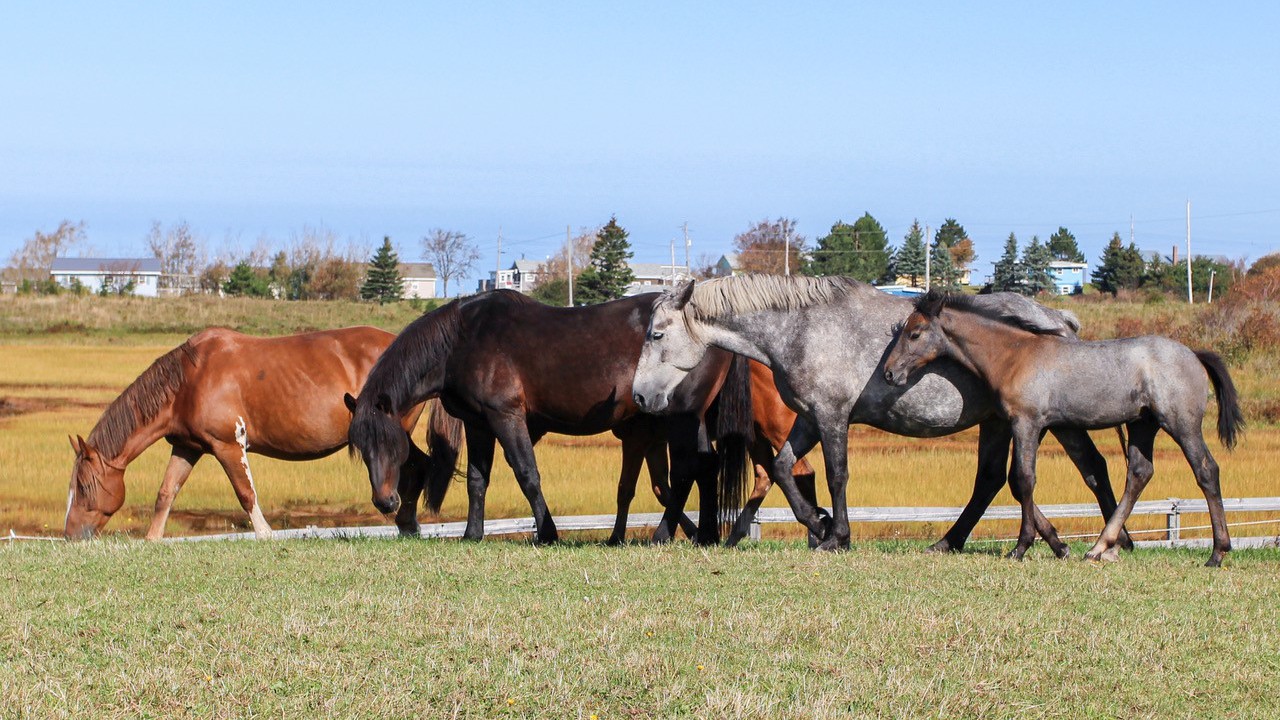
© Sarah Baker Forward
Stallion Time....
Last summer Image and Sylvie were living in the back paddocks with access to the run-in shelter which is part of the barn. From there I would move them in and out of their stalls without haltering. When we are not in training mode they may only get a halter on when the hoof trimmer comes.
One day they needed to come in, so Sylvie came first and I closed her in her stall. Then I opened the door and invited Image to his. He knew what I wanted, but he had some business to attend to. Sniff, consider, mark some fresh mare manure. Pause perhaps again. I stood, allowing him whatever time he needed. Then he walked across the aisle to his stall – pausing again at his door to sample the hay pile I left there.
Once in his stall he gave Sylvie a noisy stallion greeting since they had been separated for all of half a minute! She responded, coming close to the hatch between their stalls, making her little mare noises in return. Then they both settled down to eat their hay.

Katharine and Image
Last summer it was three years since Image came here to Fourwinds Farm. And last summer was the first time that he responded positively to me touching his body. He had liked having his head rubbed, but really did not enjoy having his body rubbed, scratched or brushed. So for a couple of years I had simply not touched his body unless necessary.
One day I was standing with the horses in the run-in and Image was reaching for an itch. I saw it was a difficult stretch for him so I offered to help. I scratched the spot for him and he responded with that gesture of horsie happiness – outstretched head, quivering lip, and half closed eyes. Ahhhh….. Then a few weeks later he showed me another good place to scratch and he responded again.
It may not sound like much but I knew our relationship had shifted. A new kind of trust was beginning to happen, both ways. Since he arrived I had been very clear – emphatic even – that he must be very careful around my small and weak human body. And he had made it clear he did not want much touching. Since this shift, we are both exploring more intimate physical interaction. When I go to let him out I don’t overreact to his gestures of touching my hand or pretend nipping. He doesn’t ever actually nip and his touches are gentle and graceful. And if I prefer it, he will back up at the tiniest gesture from me. Or he will ask me to rub his face and head.
Stallion time. I’ve allowed him time to process as he has adapted to his new home and family. We’ve both learned to stay calm and soft with each other. And three years on he allowed me to help him scratch an itch.
Photographs © Sarah Baker Forward
Do You Trust Your Horse?
Last summer I took young Maybelle to a stable an hour away to be bred to the stallion there. Maybelle was in that long transition from filly to mare. This was her first solo trailer ride since she was brought to Fourwinds Farm as a weanling, and she hadn’t been many places at all. In her whole life she had met fewer than ten horses. She lived in my small family group, and spent one winter with her minder River with a friend’s mares.
Not surprisingly Maybelle was wide eyed when we arrived. Scooting around the giant trailer, wary about entering the barn past a running fan, and fascinated by the turned out herd of a dozen or so horses. To say nothing of the gorgeous vista across the Tantramar Marsh! But she came with me willingly – with some pauses and questions – in only a regular head collar and lead. I had considered stronger equipment but I decided to trust my horse.
Maybelle was four last summer. When she arrived at six months old I knew a lot more than I did with my foals a decade earlier. She showed me how effective it is to soften in response to resistance. She was hardly halter broke when she arrived and I was just as glad for that. As I introduced the halter, leading, and tying I was determined not to pull on her face or escalate pressure, ever. Early on she showed me the alternative. Still less than a year old, I was leading her in the barn aisle and she stopped. I put a little pressure on the lead and she pulled back against it. Not hard but not forward like I was asking. I softened, put a little slack in the lead rope for some seconds, took a breath, and then asked again even lighter than the first ask. She came with me!
Over her years with me most of Maybelle’s education about horse-human relationships has come from daily interaction with me and her hoof trims every six weeks. Many months those trims are the only time she has a head collar on. (My barn, yard, and paddocks are organised so mostly I can move horses from here to there without leading them.) But you know what?!!! Maybelle now leads better than any other horse in my barn! Last spring we went for a hand walk on the beach, her second or third time. She willingly came away from the other horses and she matched my pace exactly, slowing or speeding up with me based solely on my body language. When she was worried about something she stayed close.
When we arrived last week at the new barn she did the same thing. While not entirely attentive to me, she stuck close and came with me willingly. I stayed with her for about an hour visiting with the stallion and outside for a little grazing.
I am a bit of a worrier, so I had been thinking about this trip to another barn and her being handled by people who do things differently than me. Would they bully her at all? Or put a chain over her nose? Or would she get confused by different handling? Would she get scared and how would they respond? Should I say something to them about how to treat her? Just to be clear, I had no question they are capable horse people at this barn or I would not have left her there. It’s just that my horses are now used to interacting based on connection and presence, and they are given a voice in anything we do together.
Well… I decided to trust my horse. To trust the foundation of confidence and well being that I know she has. That even if someone handled her roughly or rudely that it would not shake her up. In fact, I want my horse to experience other people’s ways even if I consider their techniques a little rude. Through her life she will encounter humans who aren’t skillful handlers. I want her to be generous with them!
It feels akin to having a teenager (from what I hear, I’ve never done this with a human). At a certain point you have to trust that you have given them the tools they need to navigate life. Of course you won’t knowingly throw them into dangerous or abusive situations. But micromanagement doesn’t work either. That only serves to disempower them. So in a funny way, trusting them is almost the same as trusting yourself. Trust in what you have done together to prepare them for life. Trust that they have the tools – and the resilience – to deal with what comes their way.
So I trusted my horse and left her at a barn with strangers (without over controlling and trying to tell them how to handle my horse which would only have insulted them). She had already made me proud by walking on the trailer after less than a minute and travelling well. When I went to fetch her two days later they said she did great. She walked on the trailer again and travelled like a pro.
But here is the funny thing! Maybelle had been ready for my stallion the night before she went there. But she refused to talk to the stallion she did not know! By the next day it was too late. Even though this breeding I planned makes sense to me from my human point of view, Maybelle said NO. I have raised her to have a voice and here it is! I trust my horse. We won’t be going back.
Photographs © Sarah Baker Forward
The Grand Lady River
It is only fitting for me to introduce River Run first. She has been here the longest, arriving in 2005. And at 27 years of age she is our matriarch and… well, guardian angel. I am not one to use that sort of language, but River has over the years helped me in so many ways. She gave me my first full Irish Draught foal, her daughter Sylvie. She raised several youngsters to be well mannered and kind horses. When I was deeply injured – and grieving for losses in my life – she carried me in all my vulnerability and sadness. Together we rebuilt my confidence as a rider and horseman. When Image joined us three years ago, she was his first teacher about how a stallion can live with his mares.
Her black eyes followed me across the yard. I could feel her watching me! But River Run was not for sale that day so we did not get introduced. I was visiting Barry O’Brien’s Orchard Hill Equestrian Center in Massachusetts, from whom I bought several mares over the years. Later Barry offered to sell River to me and we made a deal.
So River and I did not meet properly until I already owned her. When we did, I threw my arms around her neck. It might not have been her idea of a greeting, but that was my first glimpse of her generosity. She accepted my forwardness with grace.
River was not supposed to be riding sound, but with time and turnout her arthritis stabilized enough that we had years of riding together. No jumping and not too many circles, but she loved to go out. Sitting on her back I felt we could go anywhere and do anything. She carried me through healing from a brain injury and the traumatic early years of Michiel’s illness. She was the best of trail horses, giving calm and confidence to any horses riding with us.
For more than a decade River has set the tone in my herd. She loves the guys and will sometimes defer to them. But every female horse treats her with the deference befitting the one we came to call the Grand Lady River. She is not aggressive, but a simple gesture from her will move other horses out of her way. And every one of them wants to be near her. She has been a valued partner to me in raising up several young horse to be good citizens.
At 27 River is now retired and has only occassional assignments. Most recently she helped a horse named Charmer who belongs to my barn helper Evangelinia. Charm was visiting for a couple of months last fall so he could enjoy some of our extra grass and so Evangelinia and I could strategise for his ongoing rehabilitation. River chose to defer to Charmer but never overreacted to his aggressions. Watching them together – and knowing River as I do – helped me understand who Charm is and what he needs.
River needs a little extra these days – protection from weather and supplemental feeding – so she gets winter suite! From there she can talk to the rest of the herd, duck out of the wind whenever she chooses, and easily be fed her extra rations. She clearly enjoys being in the center of things after the fall months out on pasture and away from her family. Perhaps later this year she will get a new assignment helping to raise her first grandchild!
One Step
“If you are having trouble with something, try doing it one step at a time,” I said to my barn helper whose horse was staying with us for a little while. Evangelinia and her handsome red dun Charmer have a very special bond and together we have been helping him feel better in his body and mind. So, mostly walking for a while! I had set up a small labyrinth a la Linda Tellington-Jones which is a great opportunity to practice bending, responsiveness, and mindfulness.
That day I had run out of time to give my young mare Maybelle a full session. Instead, I formed the intention to have a teeny tiny session in the short distance between her stall and turn out – about 25 feet down the barn aisle. Not sure exactly what I would do, I opened her stall guard inward to put the halter on. I had with me a short bamboo stick to extend the reach of my touch. I left the door open as I put the halter on, explaining as needed (which isn’t much, just one or two touches on her chest with the bamboo) that she was not to push through me to leave the stall. Excellent! Good girl!
Next I asked her to take one step forward. Only one! Then one step back. Only one! At first she took the step as if more steps will happen right away. That looked like throwing her weight and using momentum. That is one way that walking happens but I was looking for something else. “Can you take one step only? And then wait for my next request?”
One step, pause. One step, pause. One step, pause. In those dozen steps she learned to wait for my request and keep her weight balanced over her feet! Good girl! That is so beautiful! My request was two fingers on the noseband of her halter lightly inviting her forward. The only correction a delicate touch on her chest with the bamboo. By the last four steps my request was almost imperceptible and no correction was needed. She was with me and listening. Beautiful! Thank you! Pause for a rub of appreciation and then out you go.
Incidental groundwork. Isn’t that a great expression?! Mark Rashid used it in his book, Finding the Missed Path, that I was reading recently. It is a reminder that every moment we are interacting with our horses is an opportunity to help us both learn to communicate. Maybelle turns five in 2019 and has had mindful handling her whole life. As her formal training begins, I can feel how much she already knows about how to be with humans. Her “incidental groundwork” has been delicate and precise. She wants to be connected because connection feels good!
A lot of horses – and people for that matter! – find it really difficult to take one step at a time. Using momentum is easier in a way, but not really in the long run. What happens when I need to stop abruptly or change direction?! Moving with mindfulness and attention, with weight balanced over my feet, I am poised for anything.
Charmer and Evangelinia were having some trouble in the labyrinth when I suggested, “One step at a time.” One step, pause, think. Horse and human! As I watched, they slowed down and worked together to sort out how to move their bodies through the labyrinth. Evangelinia helped Charmer find balanced and elegant steps to navigate the tight turns. In doing so she was discovering another means to guide her friend in his journey to feel better in his body and mind.
Photographs © Sarah Baker Forward, © Katharine Locke
Fourwinds Farm 2018
Fourwinds Farm is expecting quality Irish foals in 2019. While I haven’t had foals here in a decade, those years have been well spent. For much of that time it was all about the mares! Then in 2015 herd stallion Moorpark Image RID joined the family.
“Now we can start!” Not exactly sure who said it, but those words arose clearly in my mind while sitting in the barn aisle one day last winter. We have had a rough go of it in recent years, most especially 2017. My dear husband Michiel died in March of that year. He made many things possible for me including keeping hold of this beautiful farm and having the confidence to buy a breeding stallion as a middle aged amateur! Three weeks after he died I arrived in the barn to another heartbreak: Sylvie had birthed premature twins and they were dead. We didn’t know. Heartbreak upon heartbreak.
2018 was busy with breeding efforts and, this fall, getting back in the saddle. The two younger mares are confirmed in foal to Image – more about them below. Maybelle the four year old has begun her training as a riding horse. Sylvie and I are carrying on with our explorations of classical dressage. At 26 the Grand Lady River Run continues to preside over us all. Image, meanwhile, has become a dedicated family man. I look forward to riding him next year when the girls are busy with their foals.
Moorpark Image is a stallion who combines rare and performance bloodlines to present a stunning package. He has floaty athletic movement and is a very kind fellow. Selected, imported and produced by Frank Olivito, Image has produced lovely offspring throughout his life and was kept consistently in training with Adam Gamble. His get are foxhunting and eventing. I admired him for years and was honored when Frank and Adam agreed to sell him to me.
Image spent much of 2017 in Ontario at Iron Horse Equine Reproduction Services. We now have a supply of frozen semen, though it has not yet been proven. He had an Irish Draught Sport Horse filly foal in Ontario this year out of a Garryowen of Suma granddaughter. I had hoped for more, but as we know in the breeding business things don’t always go to plan. And perhaps people didn’t believe me that he may never be available again for shipping fresh cooled semen!
Fourwinds Sylvan River and All Maybelle are both the only full Irish Draught daughters in North America of their respective sires. Sylvie’s sire Garryowen of Suma (Shaun) and Maybelle’s sire Lionwood Kinsale’s Lad (Angus) are outstanding Irish Draughts who have each proven themselves. Shaun had dozens of partbred offspring bred and produced by Orchard Park Stables in Ontario They are scattered around North America showing successfully in eventing and other disciplines. Angus is one of the top performance Irish Draught stallions in the world with Gold Merit in Dressage and Silver in Show Jumping for his own performance. He is now standing in Ireland and his second crop of foals – more than twenty! – arrived this year. His foals are consistently lovely and most notable for their excellent temperaments.
Sylvie is truly one of a kind! She is Shaun’s only pure bred daughter and the only pure ID approved daughter of her dam River Run (by Powerswood Purple). River is an Irish Horse Board Quality broodmare. An impressive mare at 16.3, River produced a compact model in Sylvie who is just 15.1. Contrary to those stories you hear about Irish Draughts growing until they are six or eight, Sylvie never grew at all after her inspection at three! Shaun did produce some small ones over the years and I often wondered if he had some Connemara hiding back there in his dam line. Until she has some foals on the group it is hard to guess what size Sylvie will produce.
Maybelle comes from the outstanding mare family of Pearl Drop (Castana x Castleduff Silver), who also has two generations of proven progeny here in North America. Pearl’s Rockrimmon Silver Diamond daughter Little Gem produced an approved ID stallion son Kilronan’s Glenstone. Gem went on to be an eventer in California eventing with her junior rider. Pearl sons are out in the show ring and hunt field with one competing in sidesaddle steeplchase! Maybelle is starting to come into her own as a young mare showing her sire’s super temperament and the outstanding movement of both parents. She stands 15.3 hands now and may finish a little taller. Given the consistency on both sides of her pedigree I expect she will generally produce foals who finish right around 16 – 16.2 hands.
A new mare joined the family in 2018, although she will remain living in Ontario for the time being. Bramblewood Truth or Dare (Trudy) is royally bred for eventing! Her sire is Salute the Truth xx, who went Advanced in eventing and now has offspring doing so. Her dam is Sparrow’s Tiptoes by the reknowned Connemara stallion Grange Finn Sparrow. Trudy is confirmed in foal to Lionwood Kinsale’s Lad for 2019.
It’s all about the mares! I am very excited to be producing foals with these lovely mares. The Irish Draught gals are both very typey, meaning compact, athletic, deep through the barrel, with excellent limbs, joints and feet, and an extra dose of character. And Trudy brings top quality performance blood to the mix. Some of the foals will be for sale and I will be selective about who gets to buy them!! Please get in touch sooner than later if you may be interested in a Fourwinds Farm foal.
Photographs © Sarah Baker Forward, © Liz Freeman, ©Fade to Grey Farm

